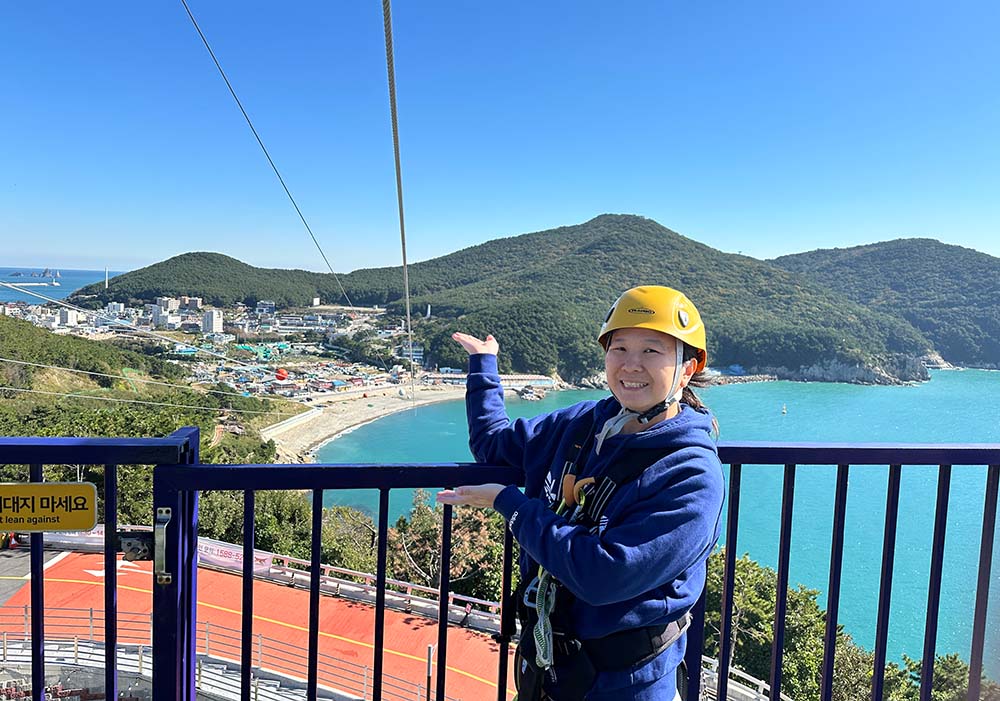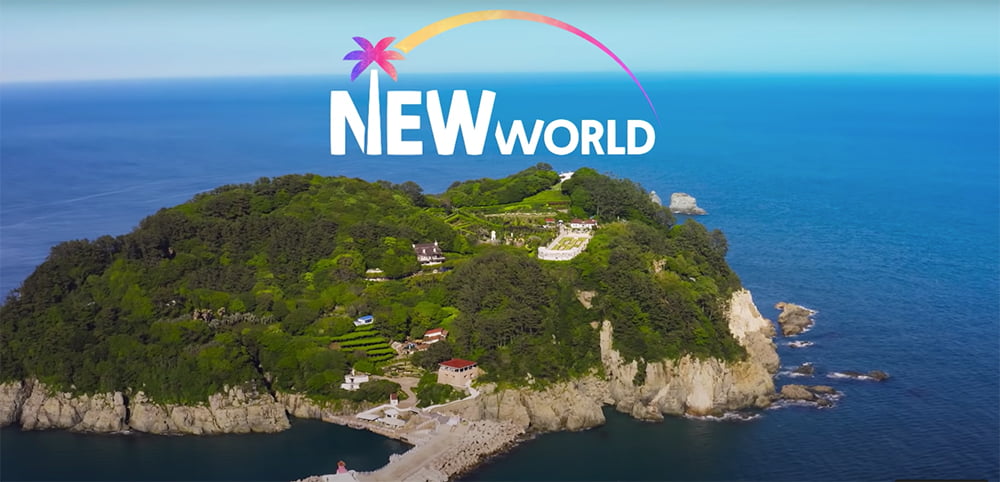If you’re visiting Busan in South Korea, one place you can’t miss out on is the famous Haeundae Beach along the east coast. East Busan may be a bit further out from the south Busan and the downtown area but it’s absolutely worth spending a day or two to visit. This post covers some of the thing to do in Busan’s eastern districts like Haeundae, Gijang and Gwangan.
I’ve been to Busan twice – solo in 2019 and on a media trip in 2024 while exploring Korea’s southern region and these are all the places that I’ve seen along the way. Check out my trip planning post for travelling in Busan with tips on how to get around and where to go.
Haeundae Beach 해운대 해수욕장
One of Busan’s most iconic spots, Haeundae Beach is the perfect place to just hang out and relax. In summer the beaches are absolutely packed with beach-goers and umbrellas. I’ve only visited in the off-seasons during late spring and early autumn where it’s generally less crowded as it’s too cold to swim even though the sun was out, but there were still lots of people out and about. Many people take off their shoes to walk along the waves and enjoy the fine white sand.
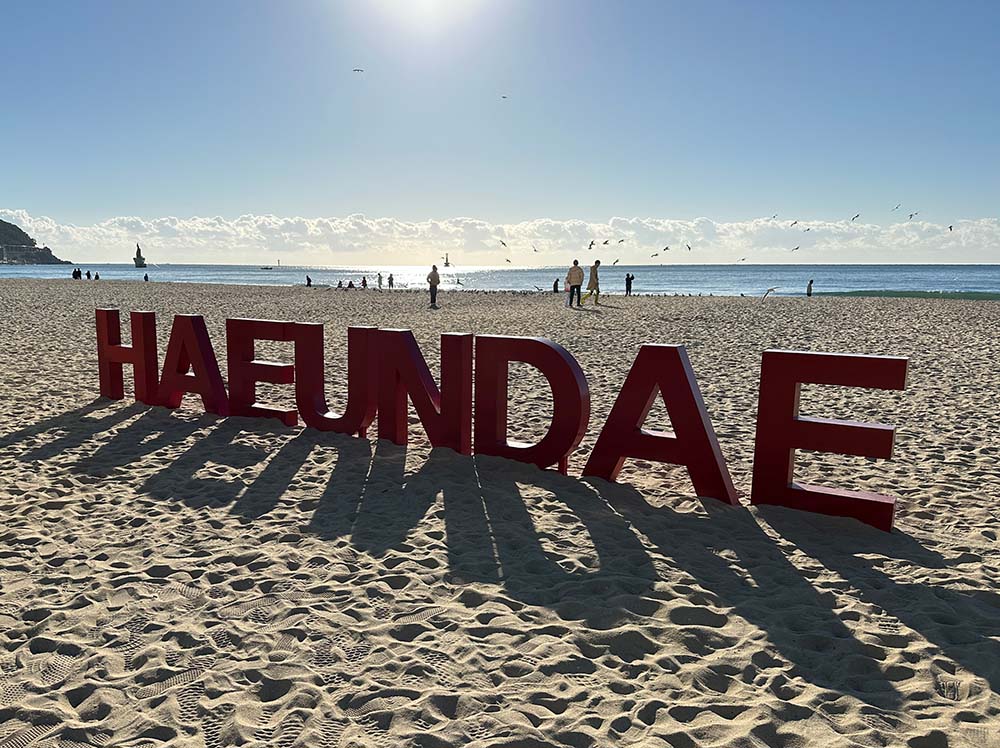
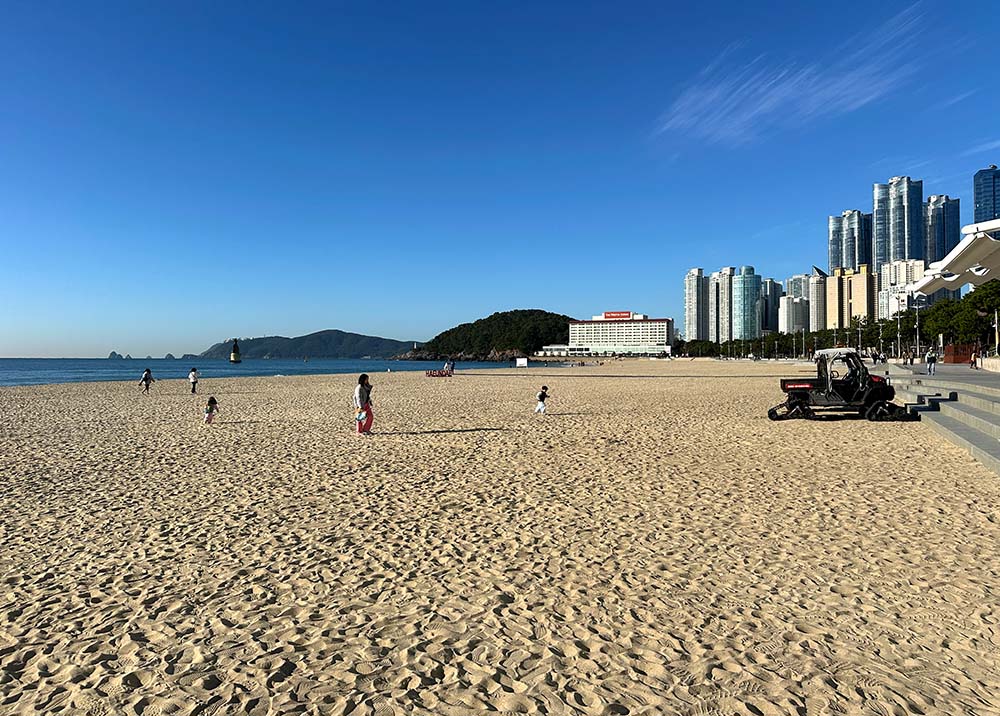
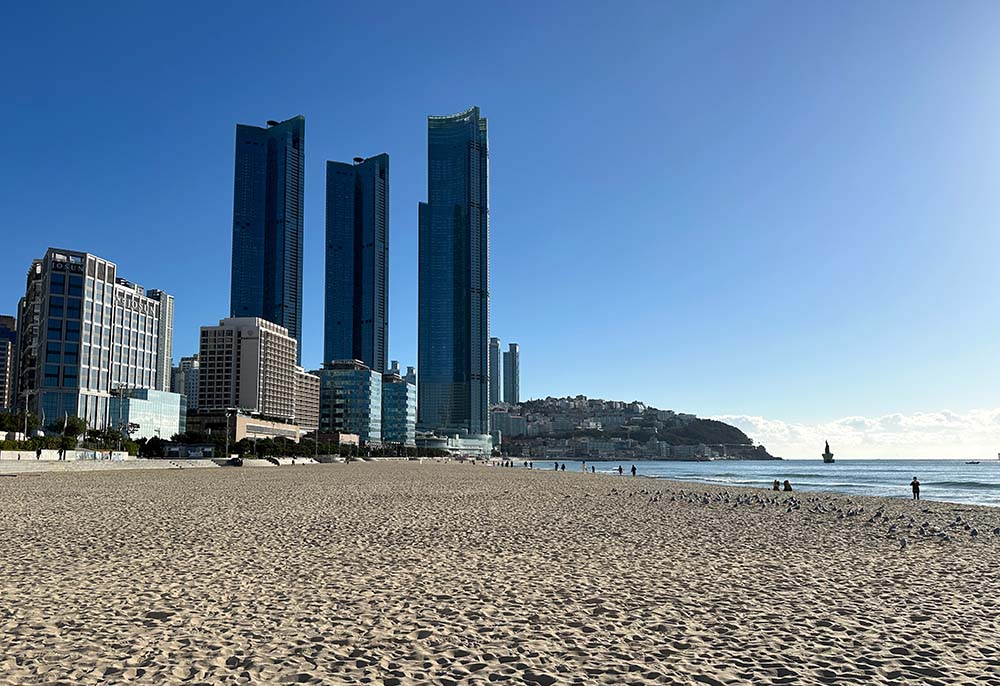
Haeundae is a pretty hip nightlife spot as well, if you want a fun place to hang out at night, visit in the evening when there are buskers playing along the beach. Lots of people were just enjoying a walk on the beach with their friends on sitting near the waves.
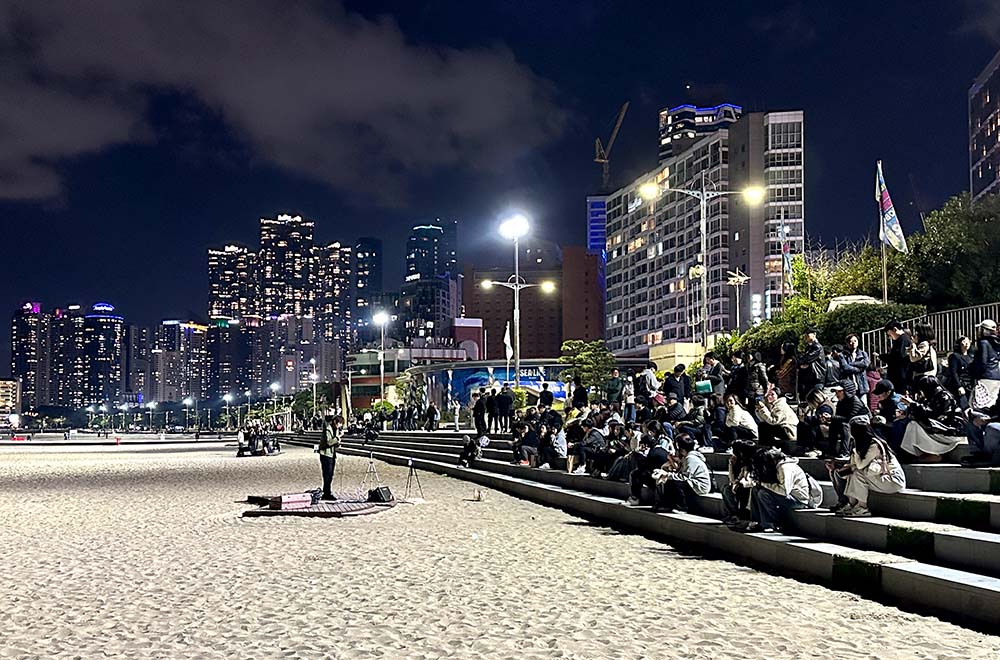
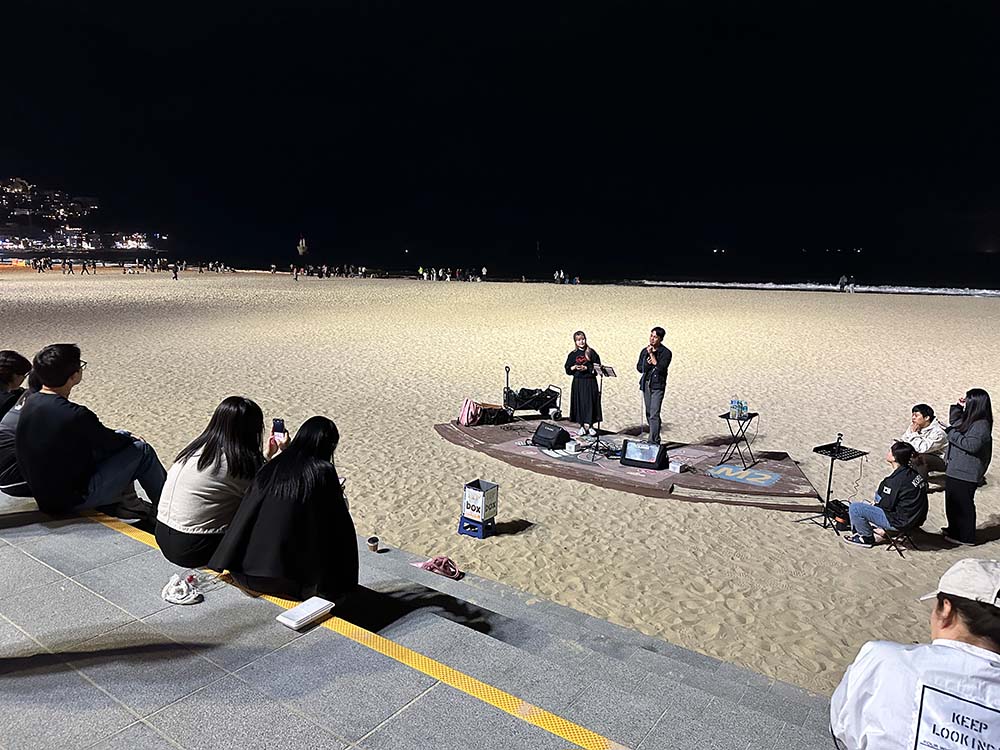
You are also a short walk away from the Haeundae Traditional Market and the main stretch of shops and restaurants, so there’s plenty happening at Haeundae Beach day and night.
Haeundae Beach 해운대 해수욕장 (haeundae haesuyogjang) [Naver Maps]
How to get there: Take the MRT green Line 2 to Haeundae Station Exit 3 or 5. Haeundae Beach is a short 5-10 min walk away down Gunam-ro.
Haeundae Traditional Market 해운대시장
Haeundae Beach is also popular for food – you can’t miss the queues lining up at some of the famous Dwaeji Gukbap (Pork Soup + Rice) restaurants along the main thoroughfare, and all the shops and neon signs that light up the roads at night.
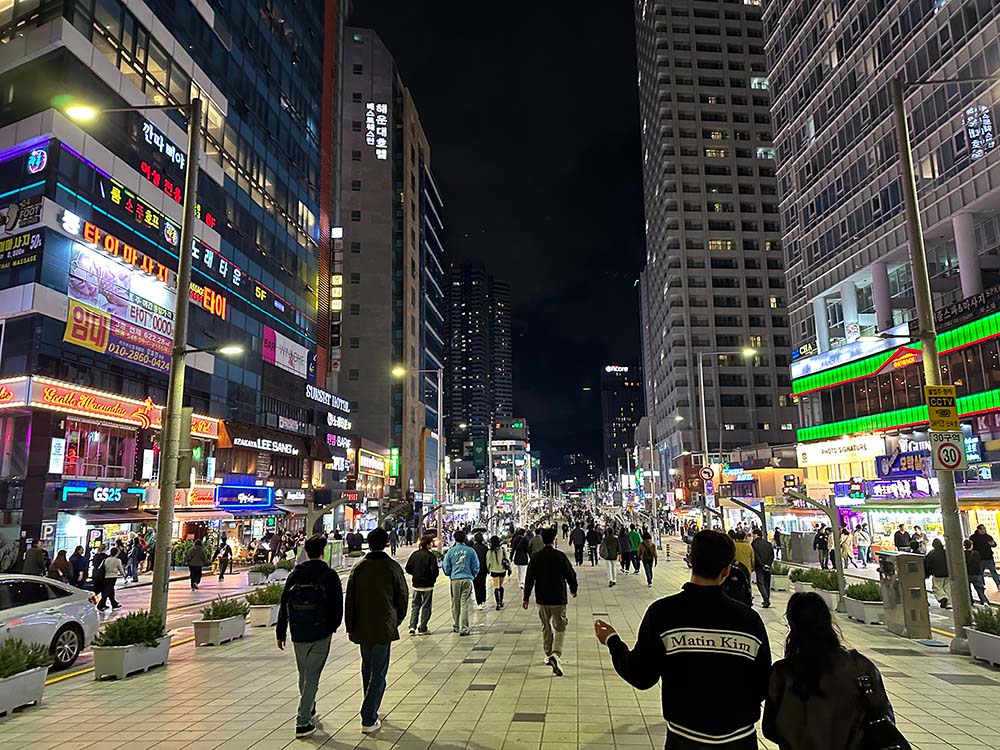
Haeundae Traditional Market is a long stretch of restaurants and street food just off this main thoroughfare – I had Eomuk (fish cake) and Tteokbokki (rice cake) among many other snacks, and you’ll also find a lot of seafood and in particular, live eel restaurants!

Haeundae Market 해운대시장 (haeundae sijang) [Naver Maps]
Details: Open 9am – 10pm.
How to get there: The market is on a small lane very close to Haeundae Beach. It’s hard to miss because there will be plenty of people around the street food stalls at that corner.
ClubD Oasis Spa and Waterpark 클럽디 오아시스 스파&워터파크
One thing I learned was that Haeundae Beach is the site of some famous healing spa waters, and there are many notable jimjilbang or Korean-style public baths located around here.
I’m a lot more familiar with Japanese onsens and hot spring culture – what I know of Jimjilbangs mostly comes from watching Korean variety shows – but in a nutshell, you can find hot spring baths in jimjilbangs, but also lots of places to lounge around, saunas and food and snacks are also a very big part of the experience. Many of these are 24 hours can even spend a night lounging around.
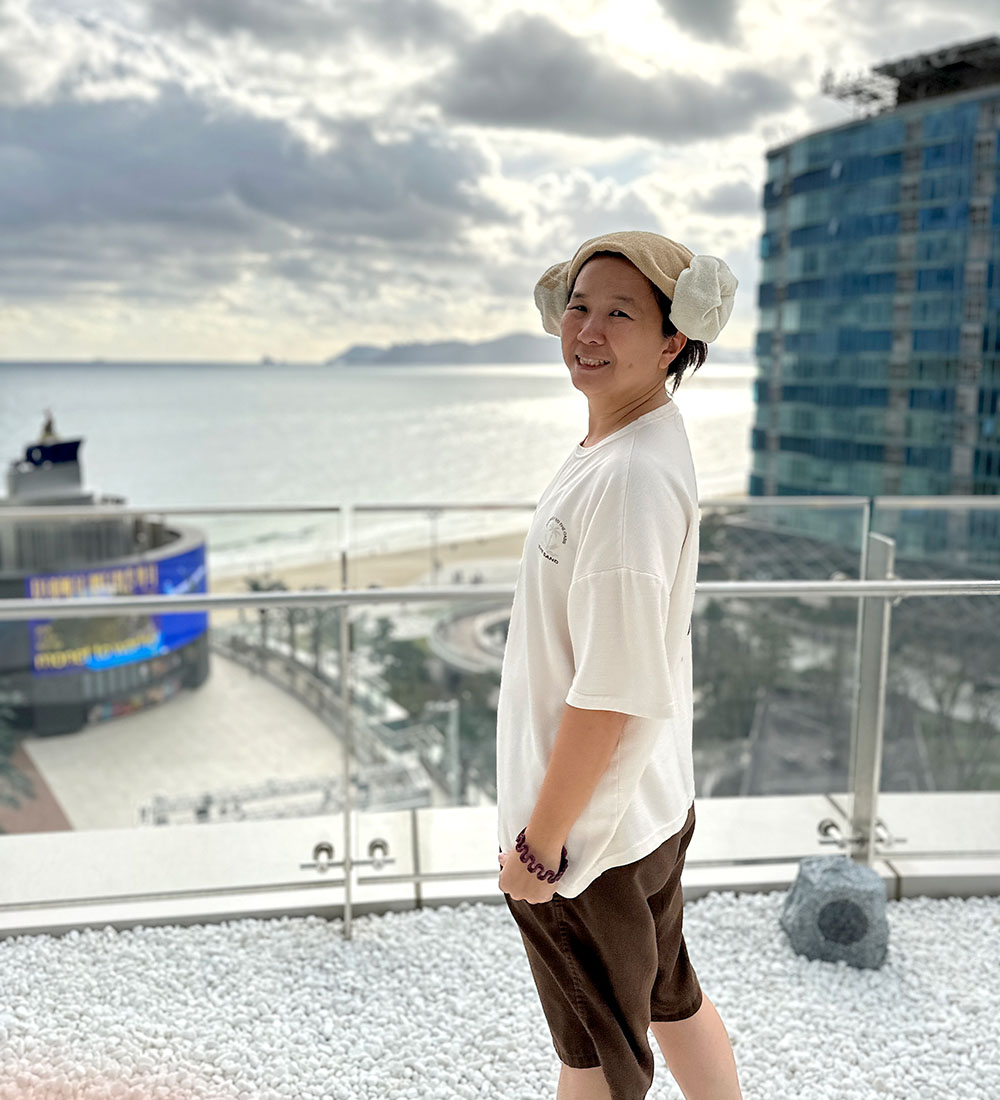
Right on Haeundae Beach in the posh looking LCT The sharp building is what I call a luxury jimjilbang. ClubD Oasis occupies the 3rd to 6th floors and it’s been awarded the 8th National Wellness Hot Spring. But beyond the hot spring baths and sauna rooms, it is also home to a fabulous waterpark with indoor and outdoor facilities, including an amazing infinity pool overlooking Haeundae Beach.
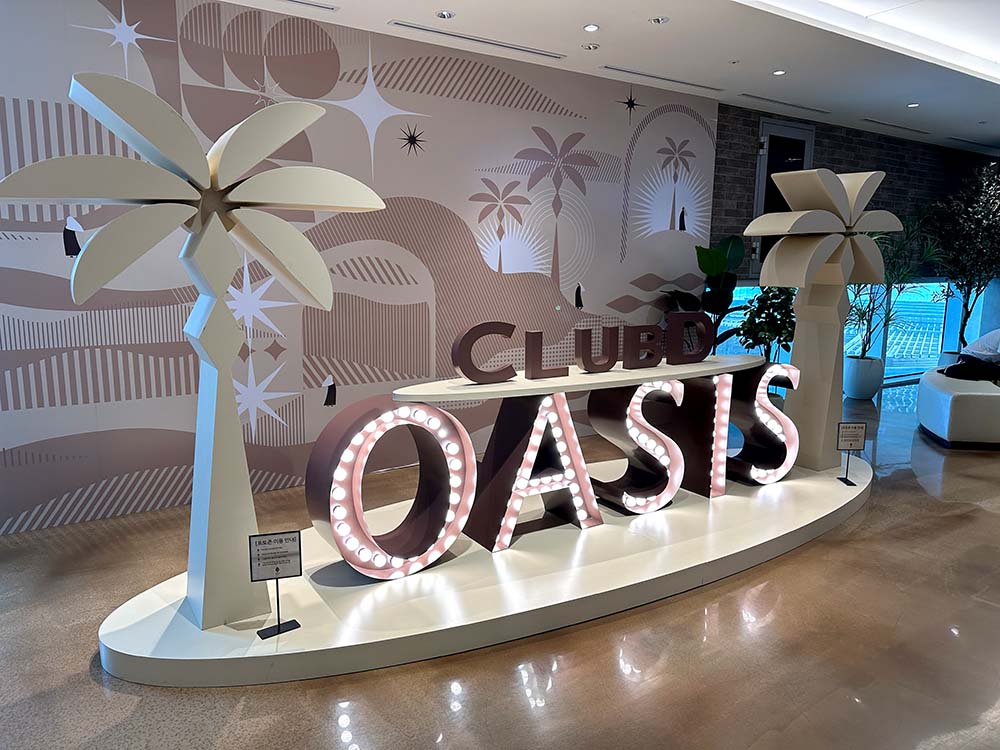
I was there on a weekday so unfortunately I didn’t get to experience the waterpark facilities, but I did get to indulge in the spa facilities. It’s a great way to experience Korean culture while winding down after a busy day of exploration.
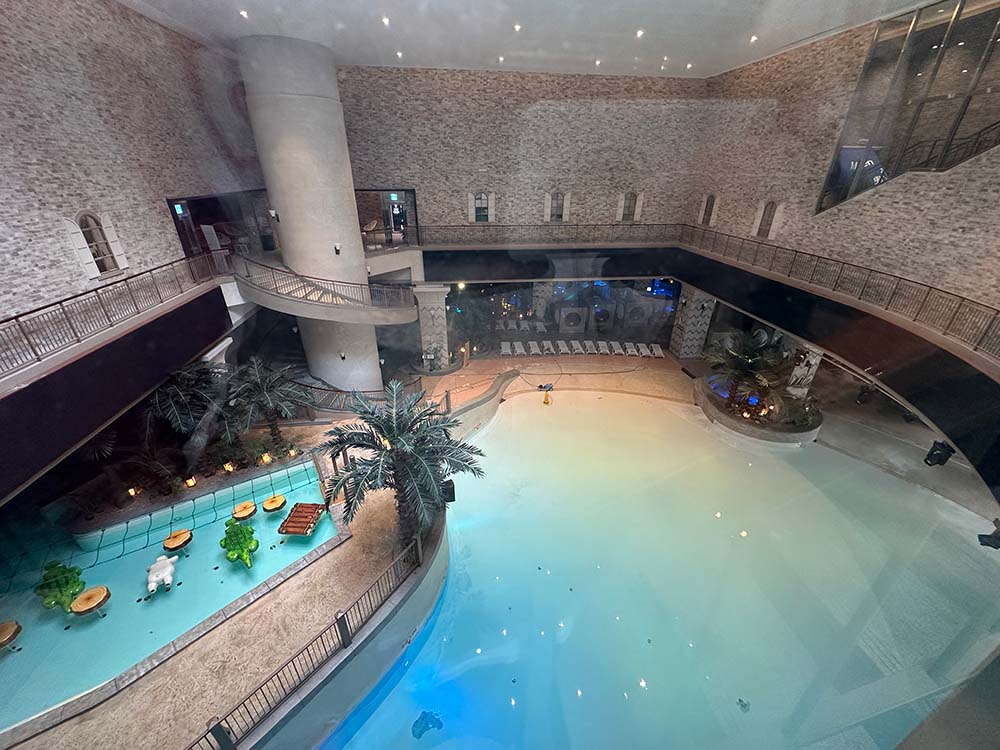
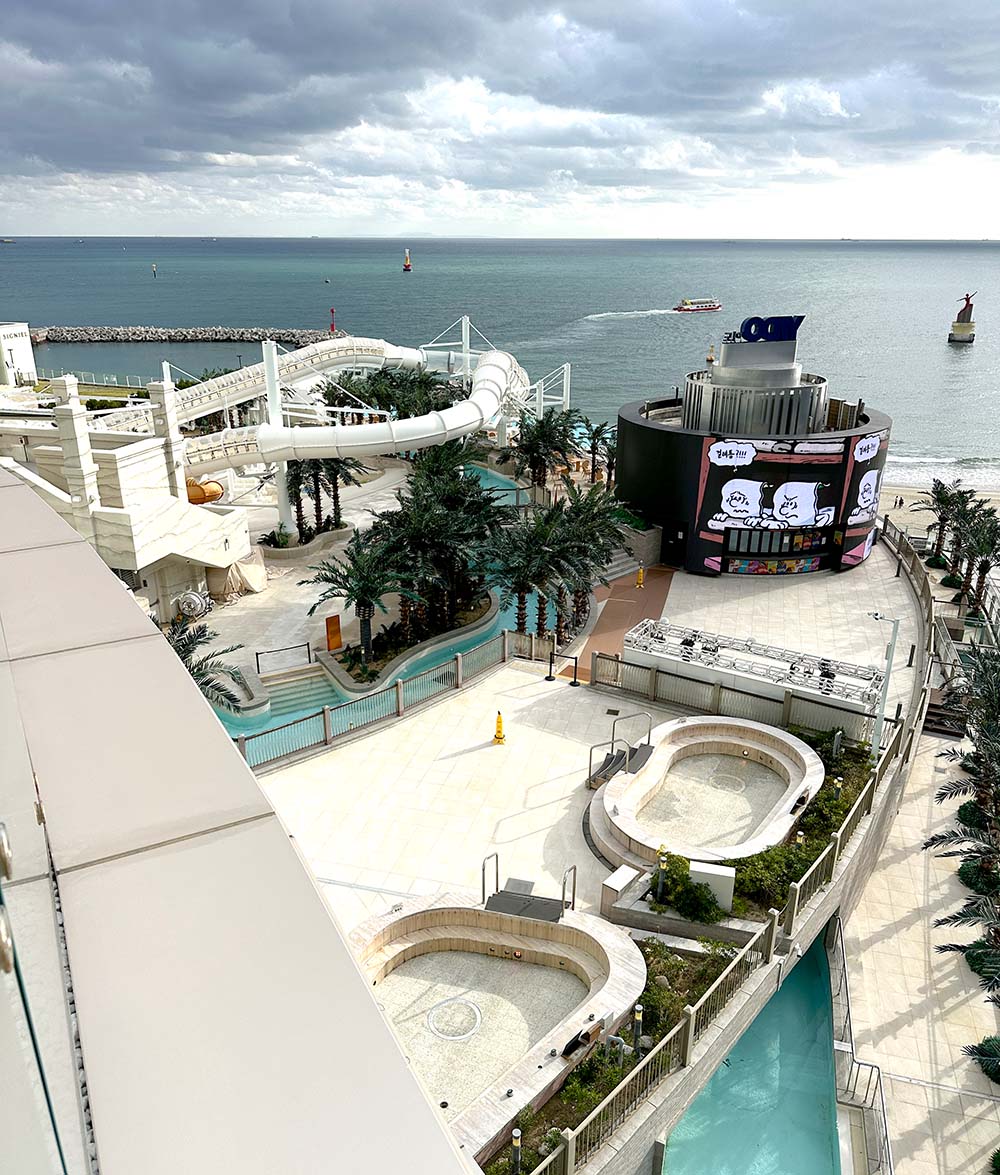
Here’s what to expect at ClubD Oasis Spa if you’ve never visited a jimjilbang before. First you check in at the counter at Level 3 and are given a locker number. That locker number is where you put your shoes. Take that locker key into a separate changing room area (gender segregated) and find that same number for another locker to store your clothes and valuables.
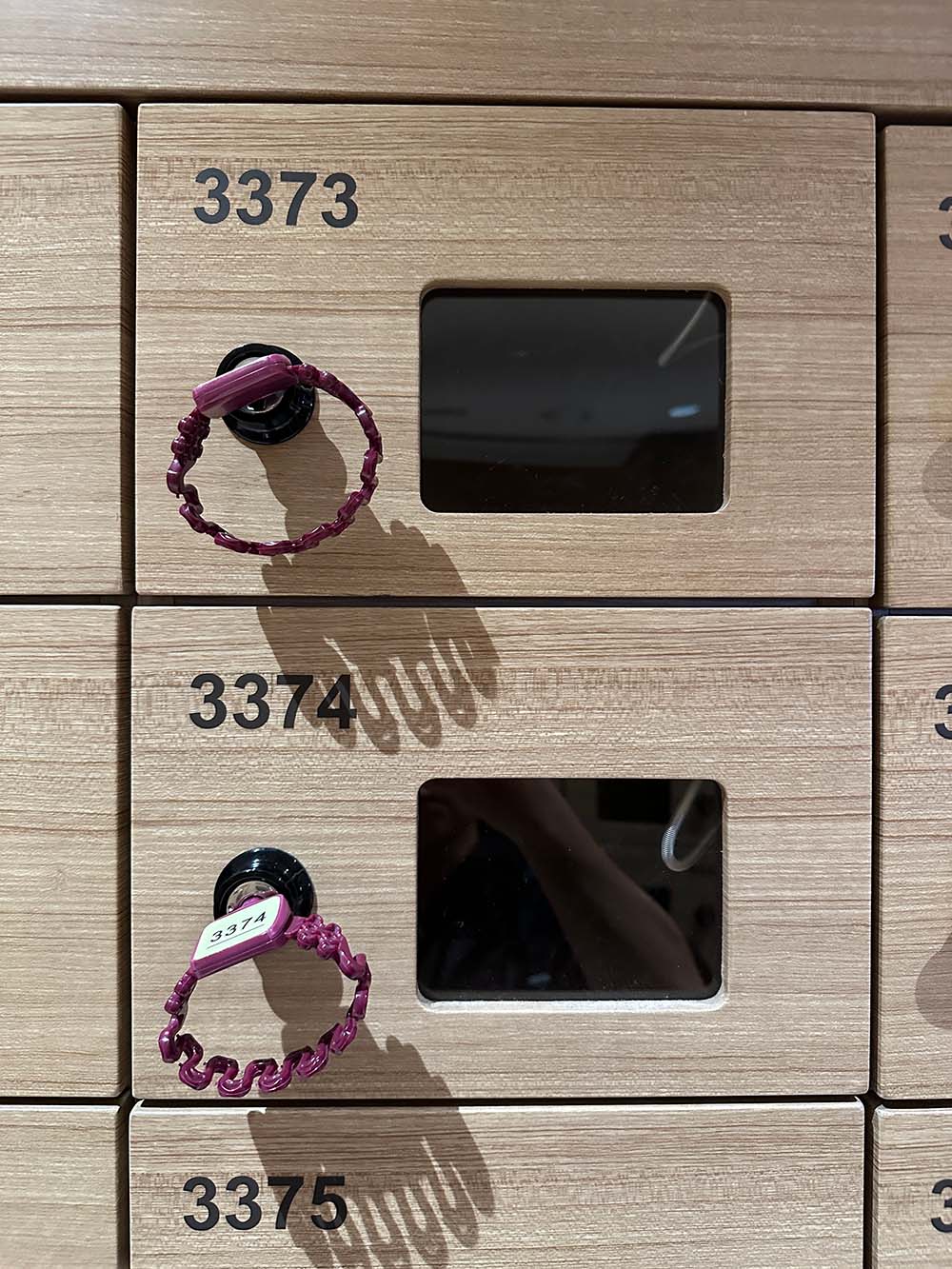
If you’re going into the hot spring baths on level 3, you do it Japanese style and go in naked, but bring your towel along to dry off, and there are stations to wash up before and after you use the pools. Obviously I didn’t take photos in this area!
If you’re going to the sauna area on the upper levels, here’s where you put on the spa clothes that are provided (a T-shirt and shorts) and you’re free to pop into any of the sauna rooms – there was a red clay one, a salt room covered with straw mats, one which had wave therapy, and even an ice cold room to contrast with all the hot rooms.
I like onsens but I’m not a big fan of saunas – something about the sweating and the super heated air making it hard to breathe makes me uncomfortable, so I liked the footbath areas best. There were the Cheongsudang outdoor hot baths (these ones you can wear swimwear into) and the open deck walking pool which is for soaking your feet, both had great views of Haeundae Beach below.
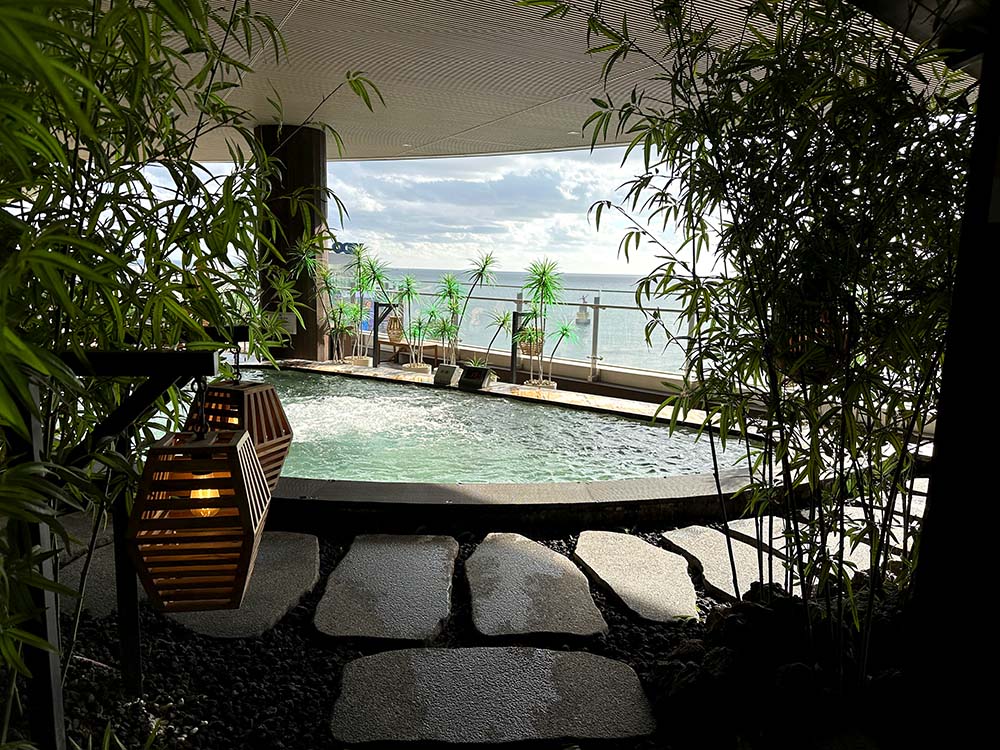
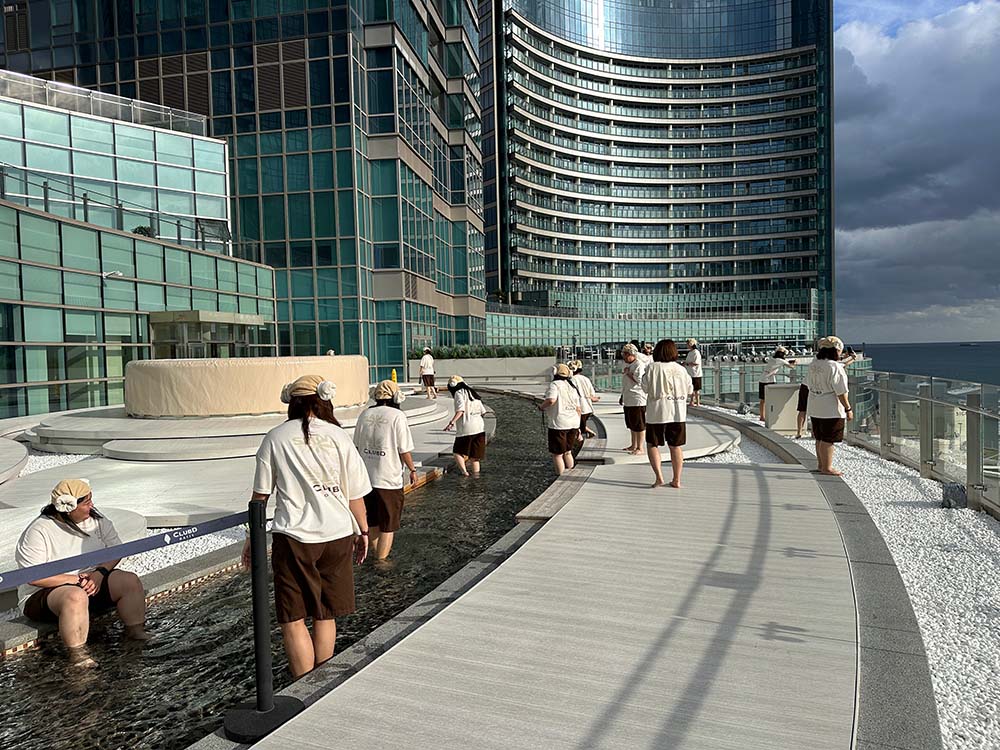
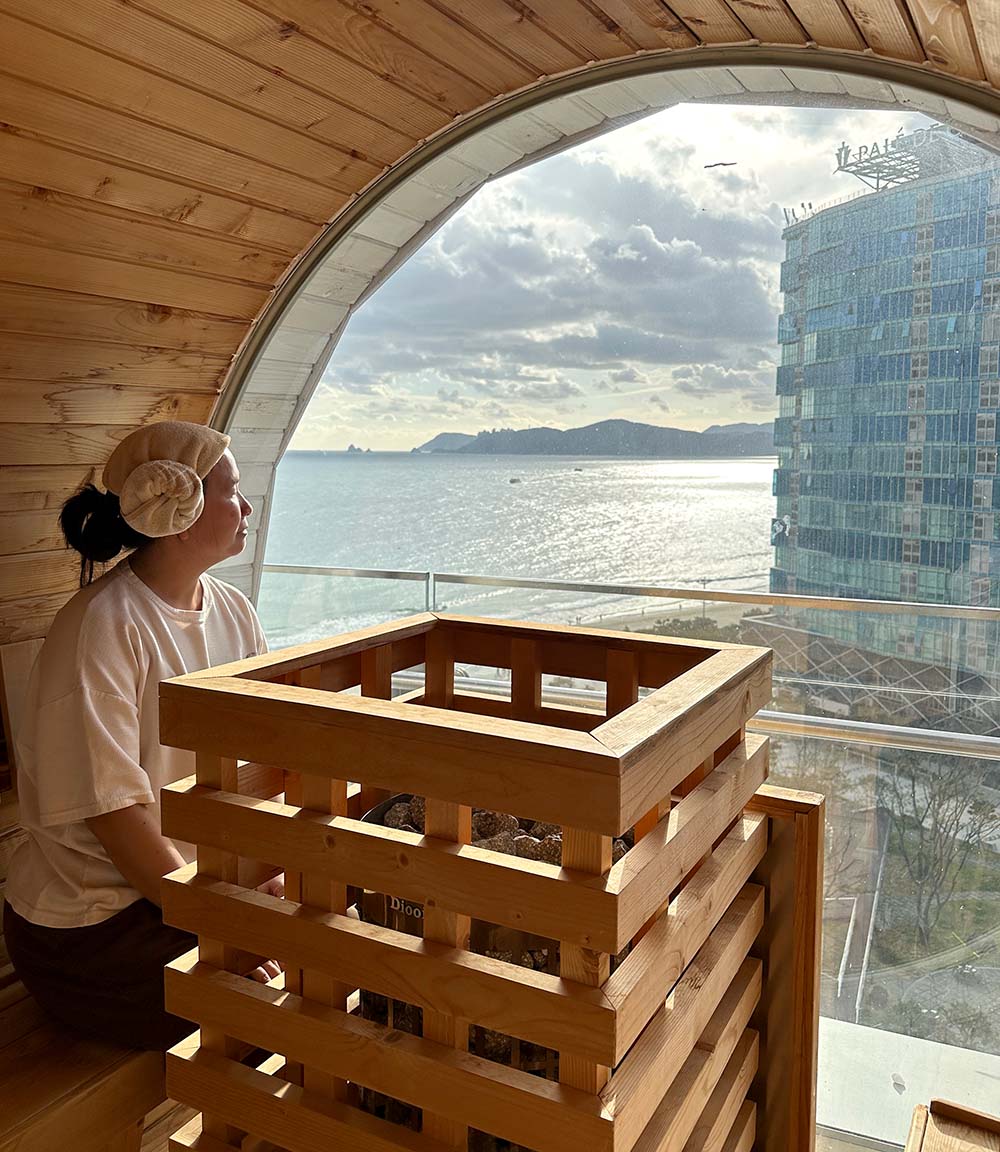
ClubD Oasis Spa and Waterpark 클럽디 오아시스 스파&워터파크 [Naver Maps]
Opening hours: ClubD Oasis opens at 10am and the spa facilities close 9-930pm. The waterpark closes earlier at 6pm.
You can buy spa tickets only (33,000 KRW) or the integrated pass that allows you to use the waterpark as well (49,000 – 79,000 KRW – there are weekday and weekend prices). See pricing details on website, or you can also purchase ClubD Oasis tix via Klook [affiliate link]
How to get there: Take the MRT Green Line 2 to Jungang Station 중동 and walk about 15 minutes towards Haeundae Beach. ClubdD Oasis is in LCT the Sharp Building on Level 3, same complex that also houses Busan X The Sky observation Deck
What’s nearby: You’re on the Mipo end of Haeundae Beach, right across the road from Mipo Station in Haeundae Blueline Park. Dalmaji Road is also very close by.
Haeundae Blue Line Park 해운대블루라인파크
When I first visited Haeundae in 2019, I came across this abandoned train line at Mipo which led me to a staircase up to Dalmaji Road. Now in 2024, I returned and this area has upgraded so much – they’ve built the Haeundae Blue Line Park which has a scenic train and sky capsule that traces the coast to Cheongsapo and Songjeong Beach further east.
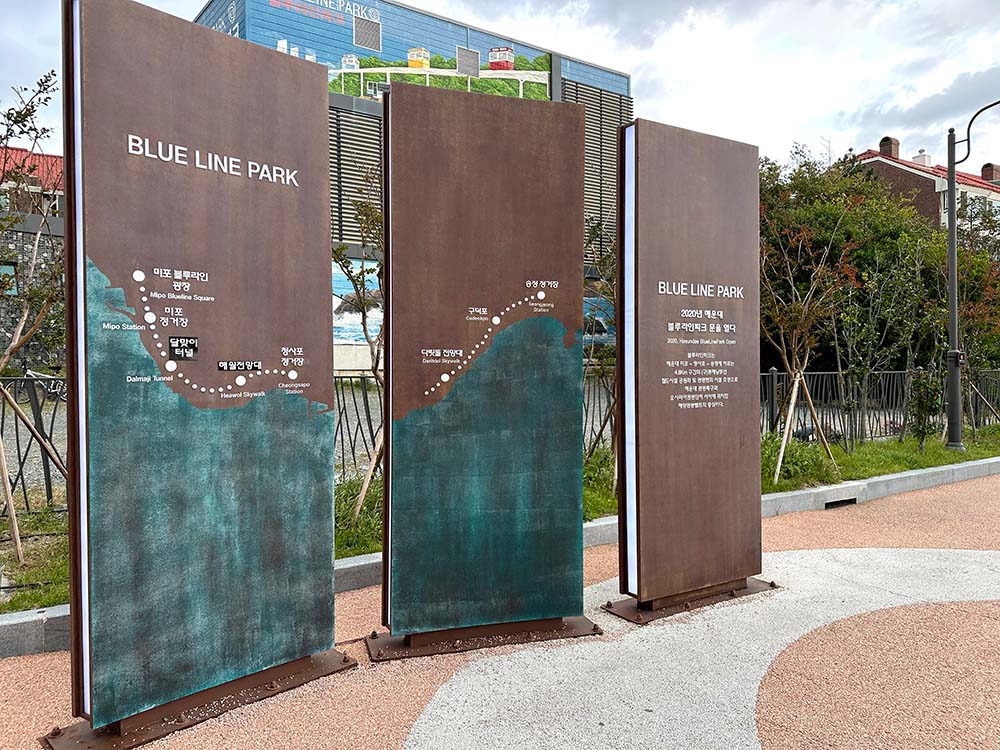
Haeundae Blueline Park 해운대블루라인파크 [Naver Maps]
How to get there: Take the MRT Green Line 2 to Jungang Station 중동 and walk about 15-20 minutes towards Mipo Blueline Station close to Haeundae Beach.
Mipo Blue Line Square 미포 블루라인 광장
On this eastern end of Haeundae Beach is Mipo Station, one end of the Blue Line where you can hop on the scenic train or the sky capsule. You can also opt to just walk this stretch on the boardwalk built next to the tracks which makes for a nice coastal stroll.
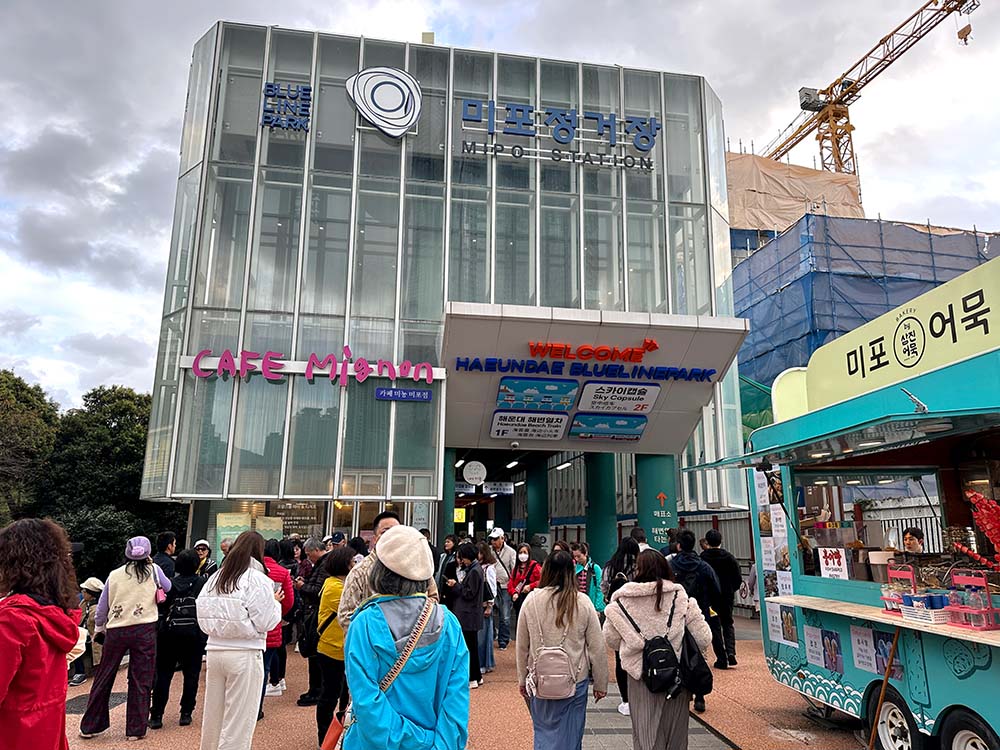
The Sky Capsule is a cute little private cabin that trundles along the coast. Like a cable car there are capsules running at much more frequent intervals but the capsule itself is pretty slow moving.
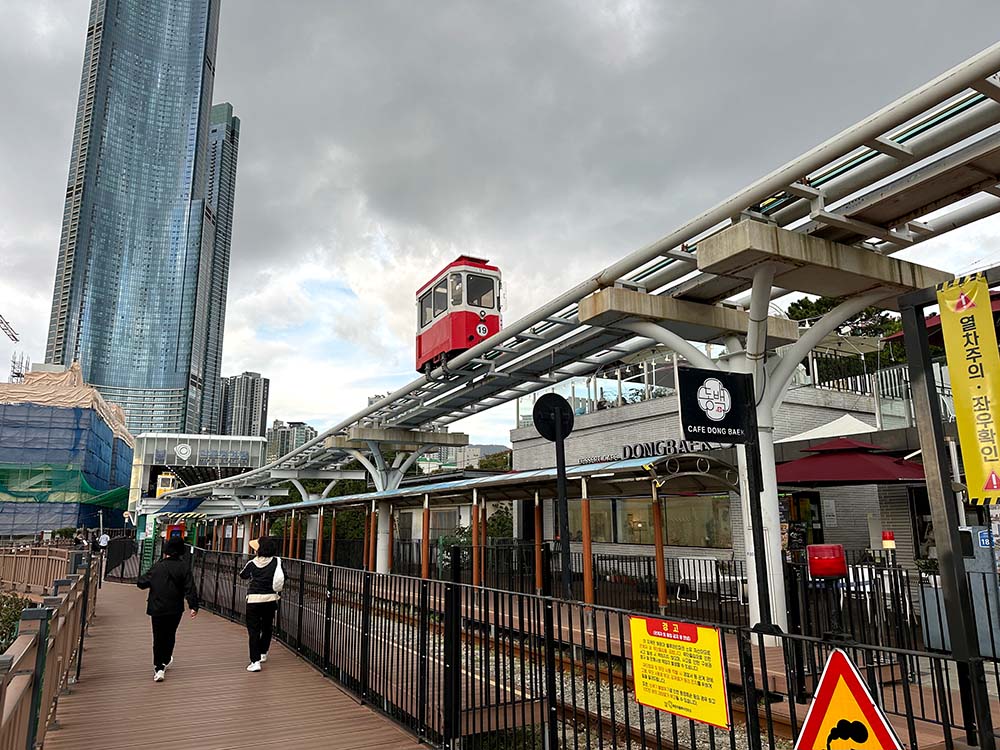
The scenic train is interesting because the seats are like a gallery and all face the coast. There are less trains in an hour but the train does cover a longer distance going all the way to Songjeong in about the same time as the sky capsule.
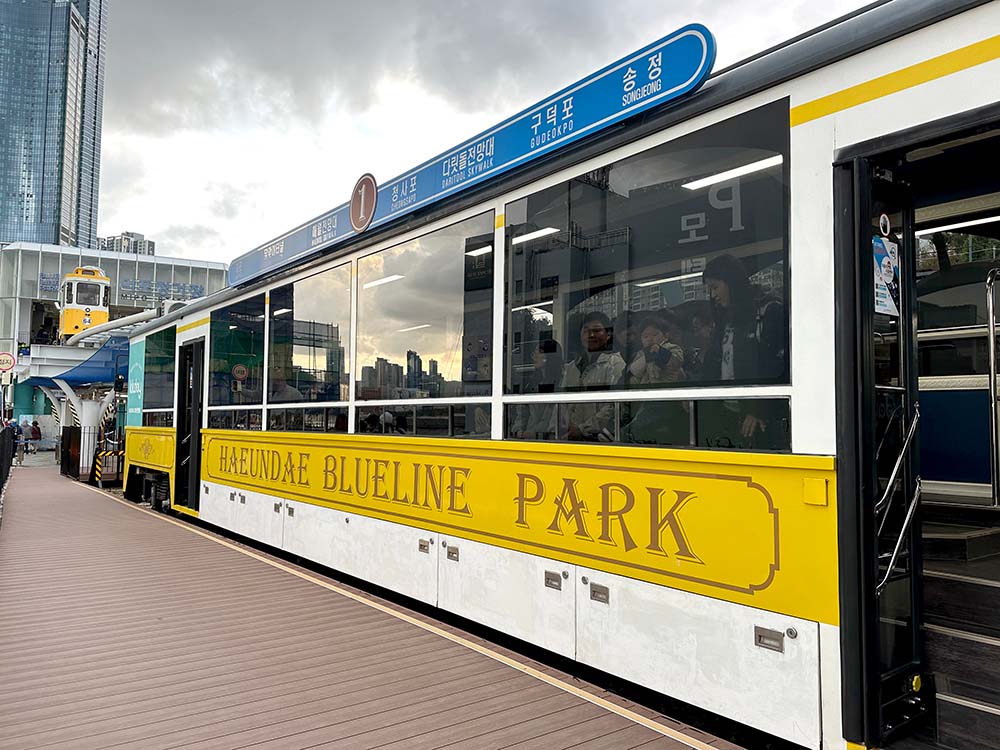
Buy your tickets from Haeundae Blueline Park from Klook [affiliate link]
Sky Capsule
Sky Capsule runs from Mipo to Cheongsapo (2.8km) and takes about 30 minutes 1-way.
Opening Hours: The Sky Capsule opens 9am and ends at 6-830pm depending on the season. See timings here.
Cost: A capsule for min 2 pax starts at 40,000 KRW 1-way.
Beach Train
The Beach Train runs a longer distance from Mipo to Songjeong (4.8km) and takes about 25 minutes 1-way.
Opening Hours: The Beach train opens at 930am and ends 630-930pm depending on season. Trains run 3 times an hour. See timings here.
Cost: A ticket costs 8,000 KRW 1-way and 16,000 KRW for a 1-day pass where you can hop on and off.
Dalmaji Tunnel Station 달맞이터널 정거장
I only had a short amount of time so I didn’t buy a ticket but chose to walk to the closest station, Dalmaji Tunnel Station. The boardwalk is very well paved and there were lots of casual walkers and joggers along the way. There was a little turnoff to a staircase that you can take to climb the hill to Dalmaji Road.
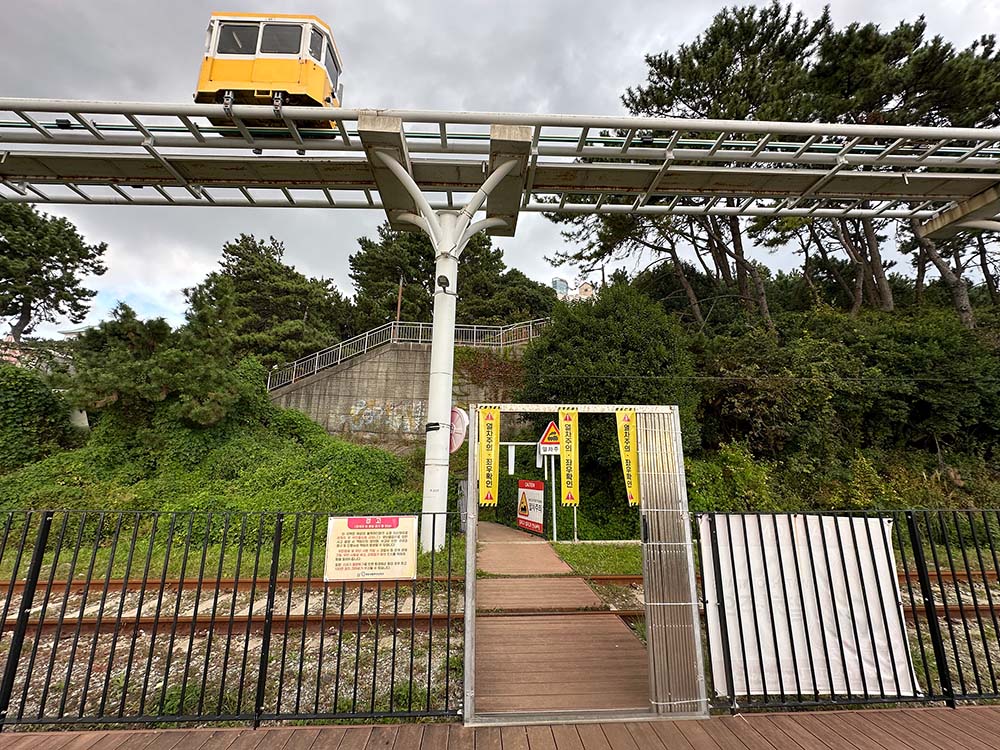
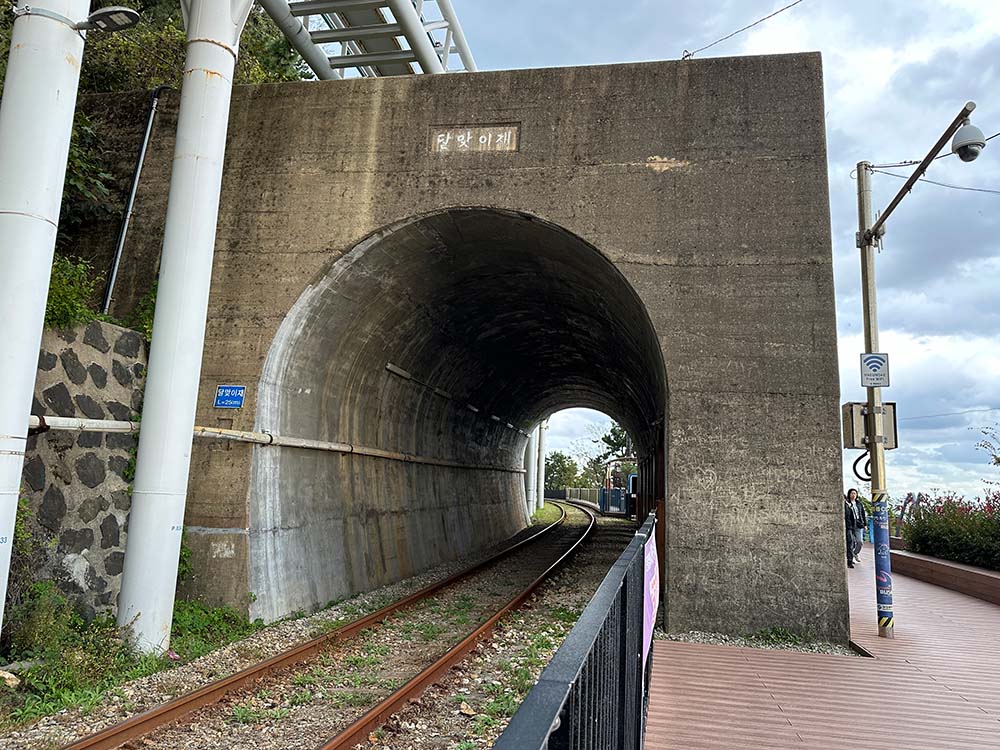
Along the way there are some scenic viewpoints you can visit as well to better appreciate the lovely coastline. I imagine this must be a pretty spot if you can wake up for sunrise.
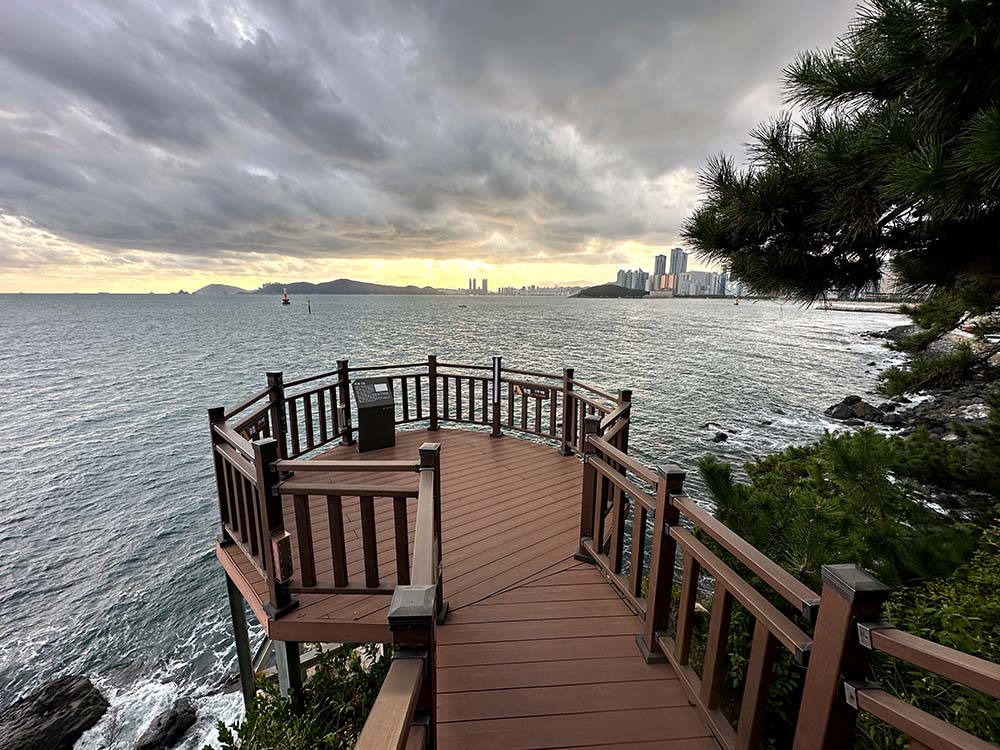
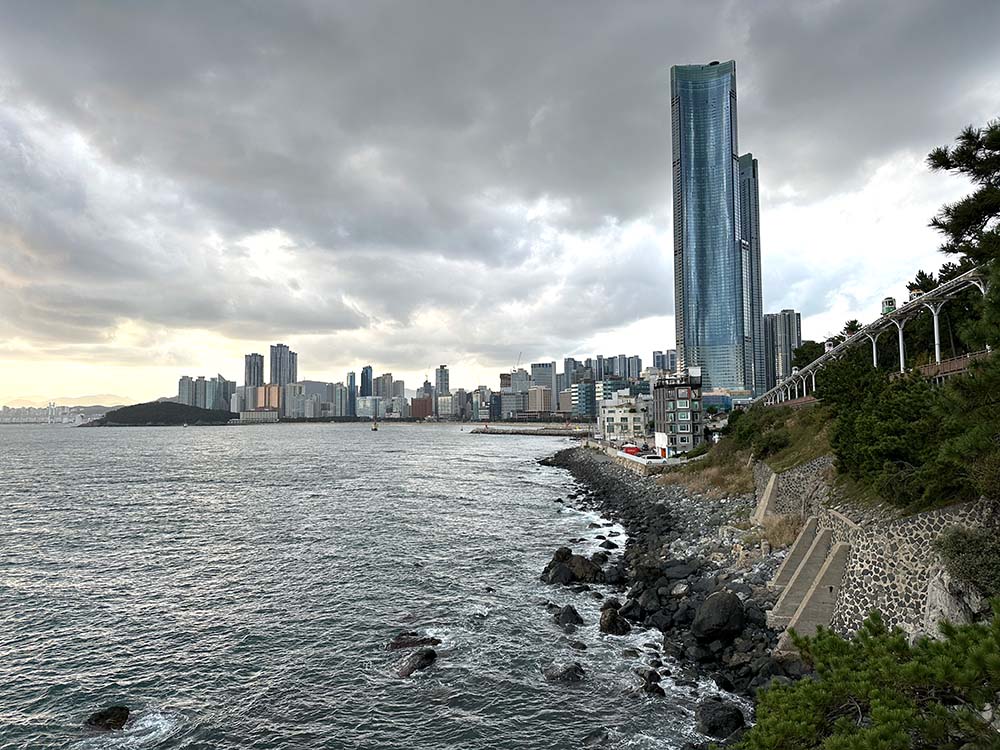
Dalmaji Tunnel Station 달맞이터널 정거장 [Naver Maps]
Dalmaji Road 달맞이 길
Dalmaji Road is a stretch of road winding up Dalmaji Hill that’s shaded by large tree canopies and considered one of the prettiest places to be during the cherry blossom season in Busan.
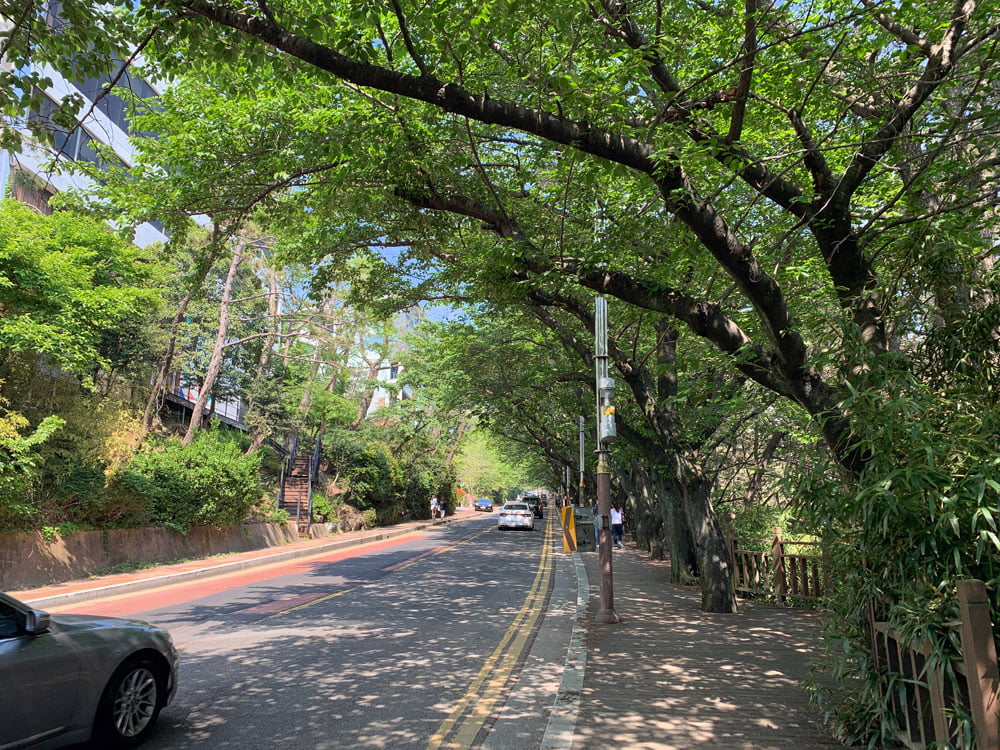
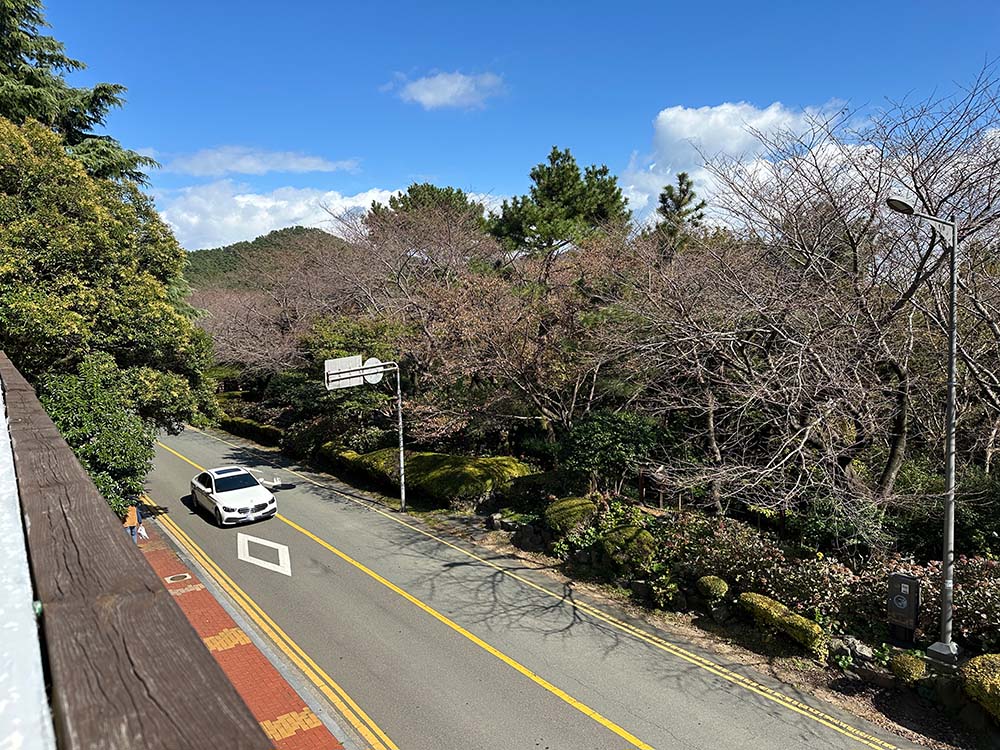
Besides soaking up the atmosphere and admiring the view from up here, Dalmaji has also become one of those cafe hotspot areas where you can just hang out for a cuppa. Art lovers will also find lots of little indie art galleries to pop into around this area.
Bibibidang 비비비당
Bibibidang doesn’t look like much from the outside, but this tea house along Dalmaji Road offers some pretty amazing views of the nearby Cheongsapo Coastline area while partaking in traditional Korean tea ceremonies.
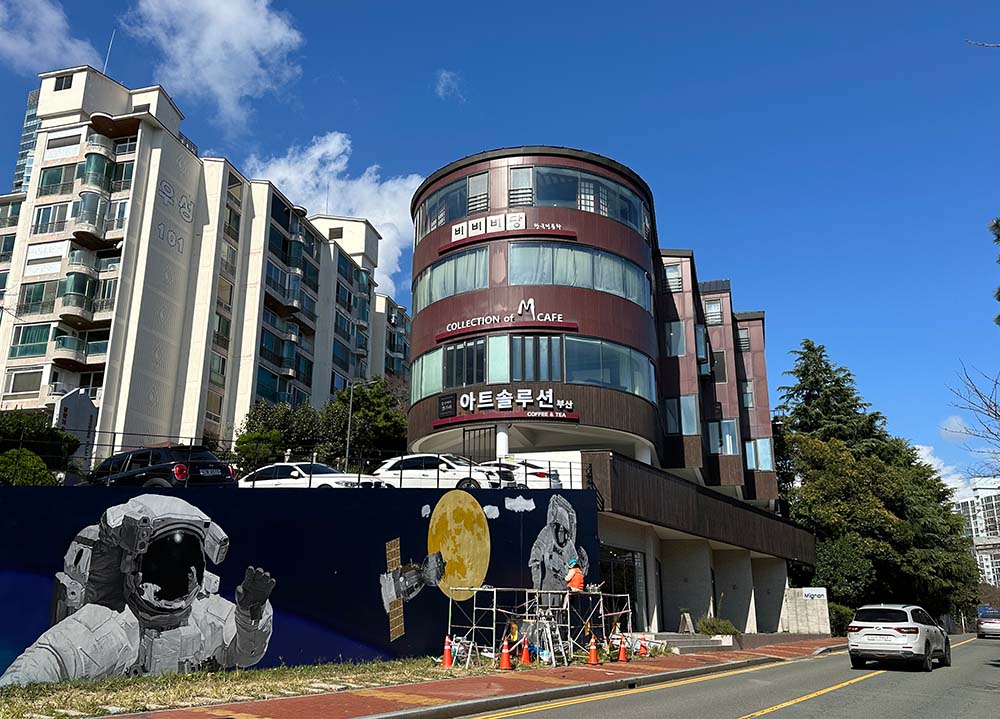
The cafe itself offers various types of seating where you can enjoy views while sipping tea, which is perfect for a lazy day out.
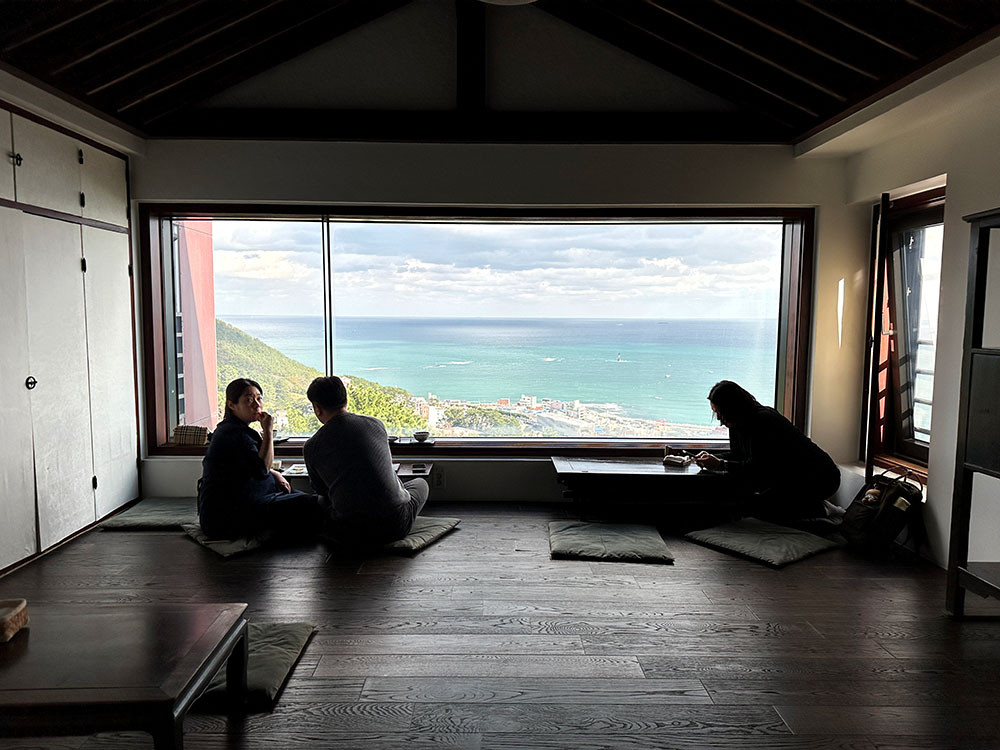
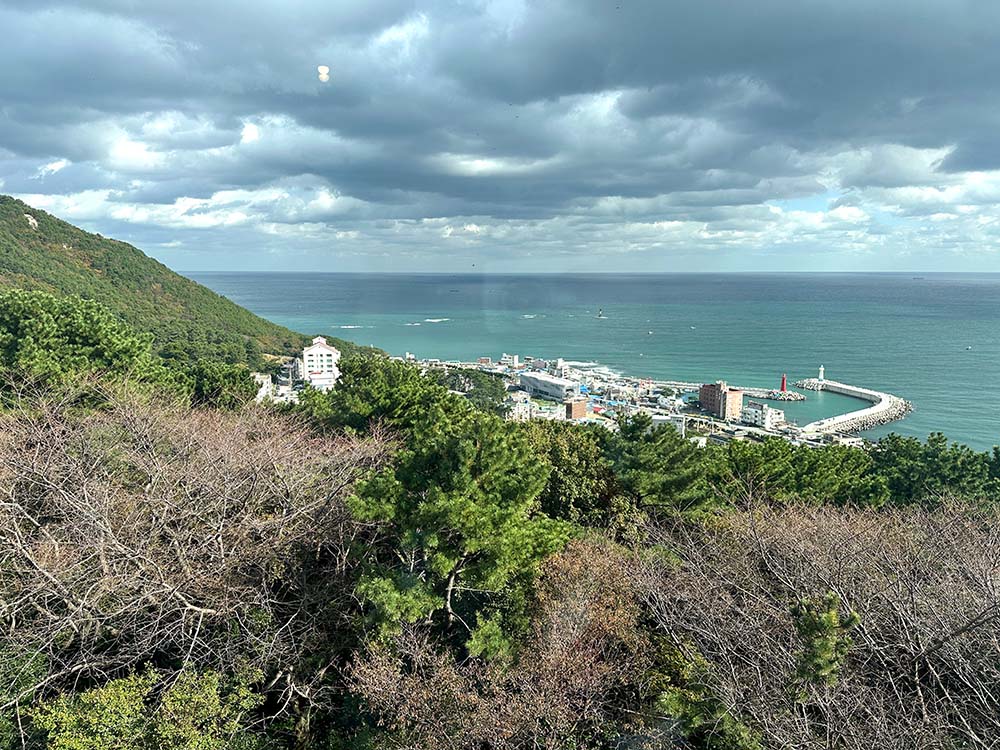
I never realised that Korea had its own version of traditional tea ceremonies – known as darye, the Korean tea ceremony seems like a bit of a blend of what I know from Chinese and Japanese tea ceremonies. Green tea is the tea of choice, and there are almost ritualistic methods to brew and sample the tea.
Korean style tea is brewed and drunk out of bowls, and in this case we had our choice of Goryeo celadon or Joseon porcelain bowls, all of which were a few centuries old! We were guided through this process by our handsome and surprisingly young tea master in traditional hanbok, very meticulously whisking and mixing the tea for us.
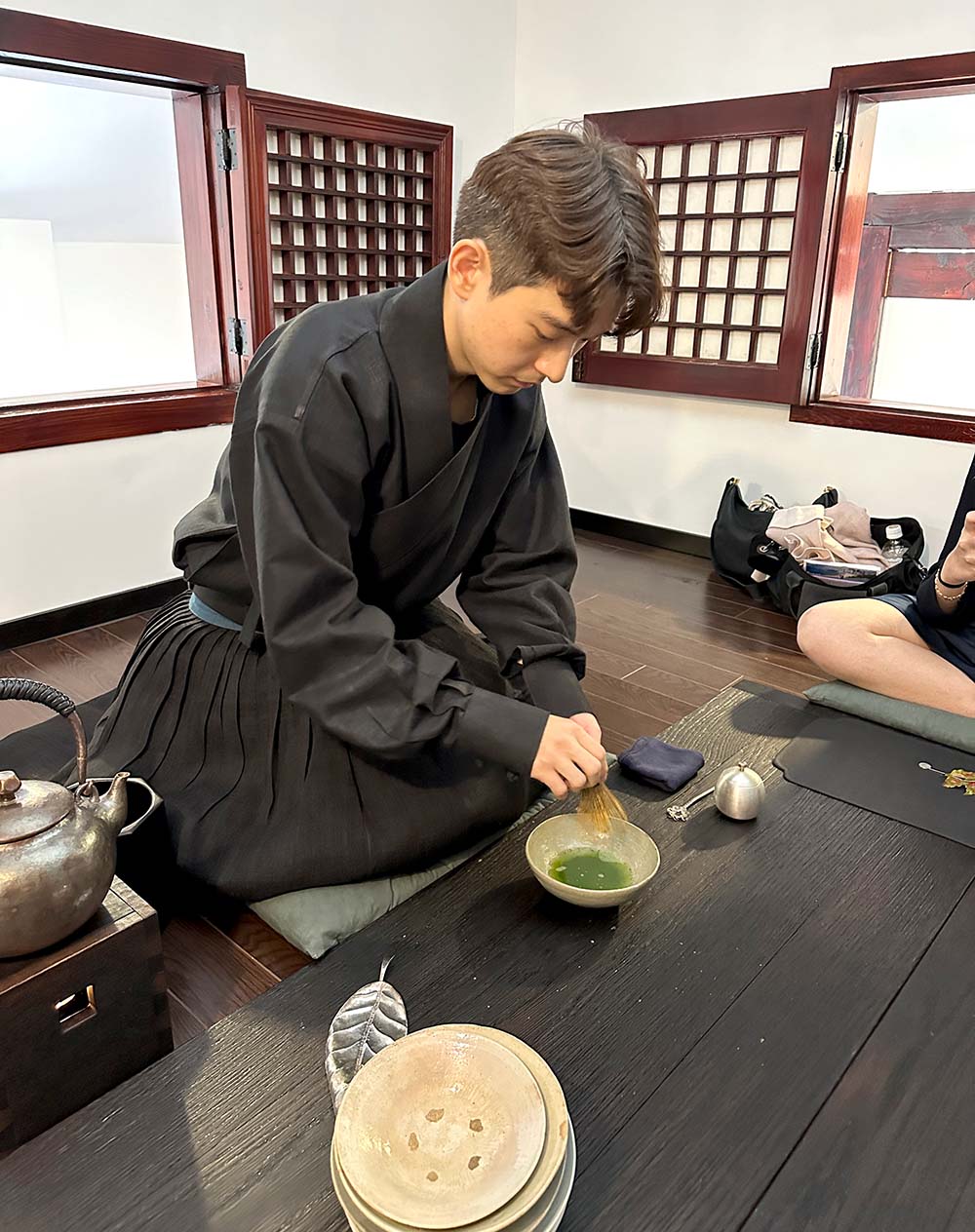
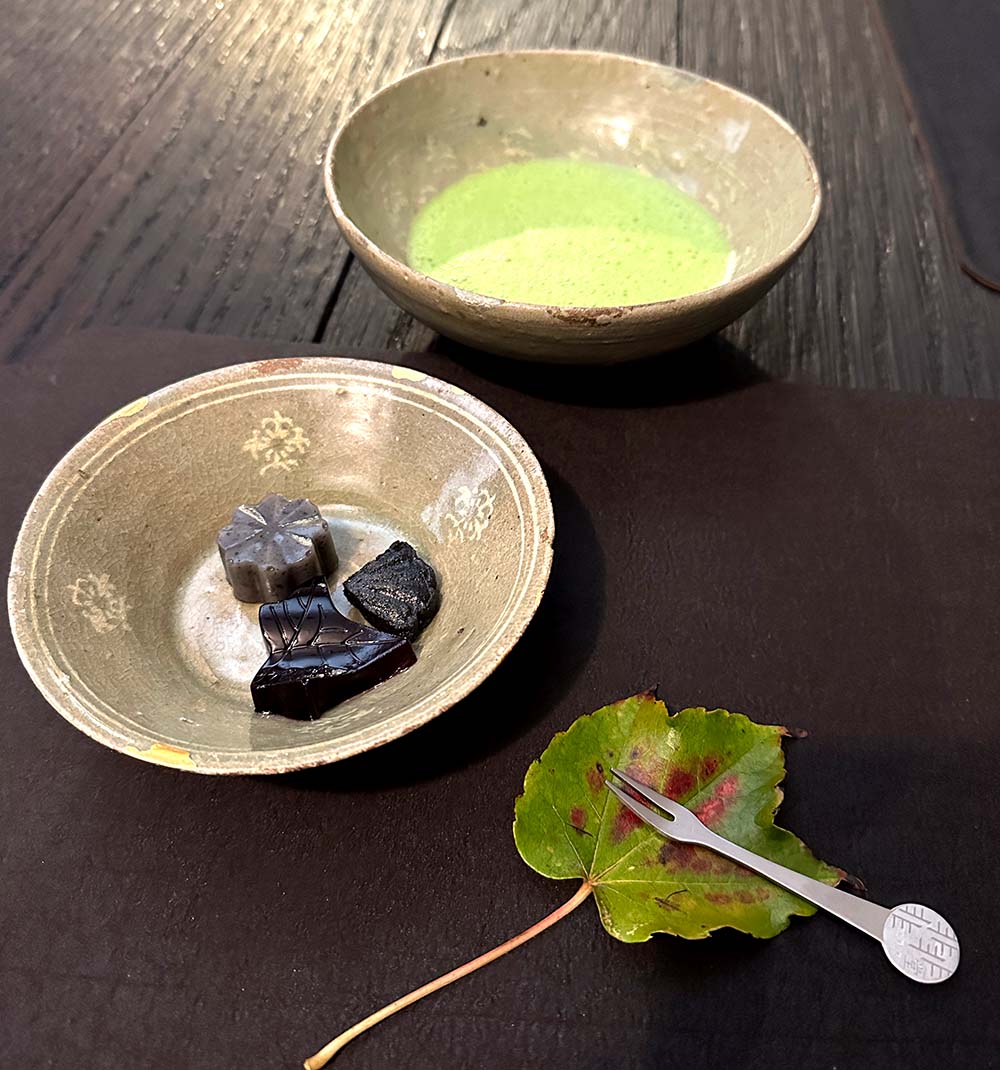
Bibibidang 비비비당 [Naver Maps]
Opening hours: Open daily from 1030am – 930/10pm. Tea ceremony courses go for 50,000 KRW per person.
How to get there: Located on Dalmaji Road, the closest bus stop is a short walk away where Haeundae bus 2, 7 and 10 stop at [Naver Maps]
Dalmaji Bridge
Along Dalmaji Road is a small white arch bridge where you can stop and enjoy views from.
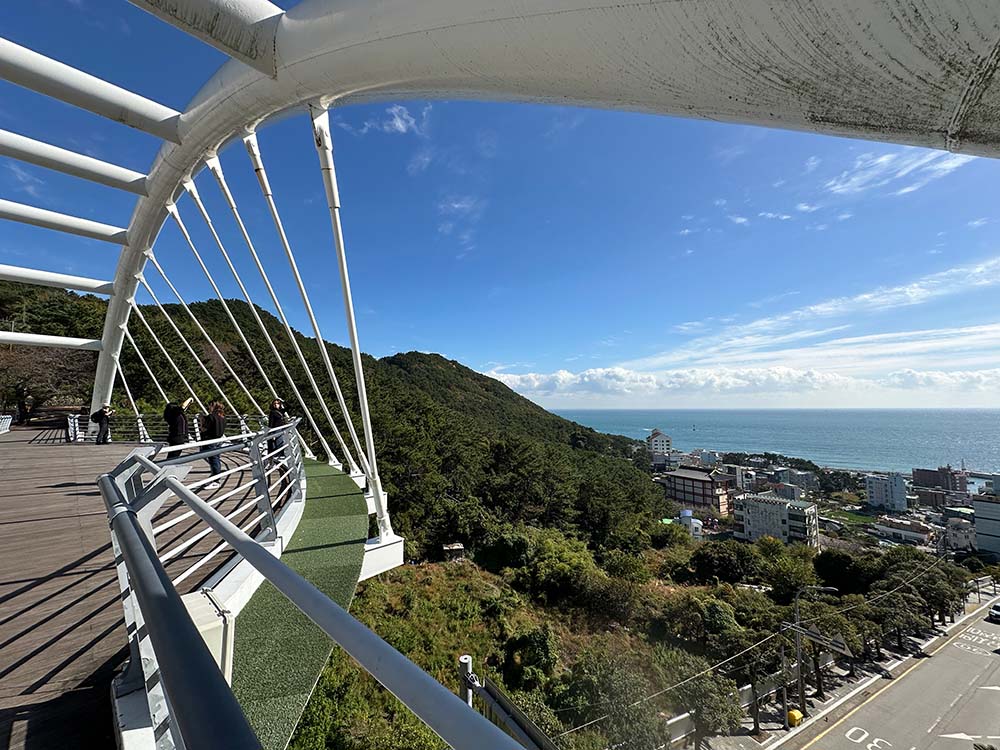
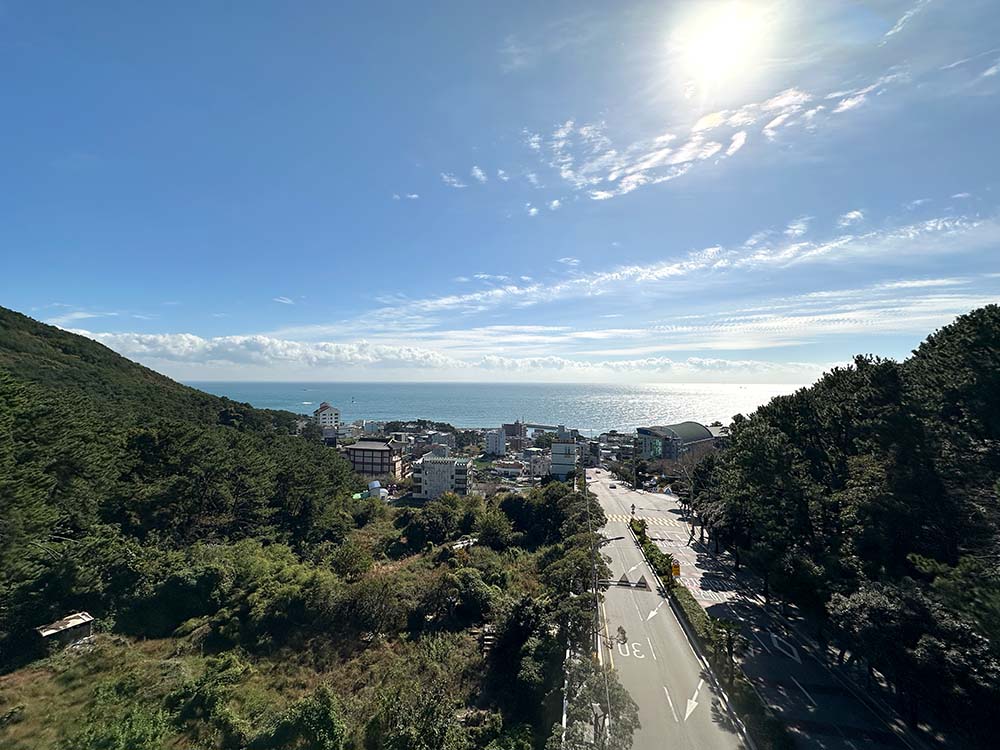
Dalmaji Bridge [Naver Maps]
Haedong Yonggung Temple 해동 용궁사
There are plenty of temples in Korea and Busan, but what makes Haedong Yonggungsa in Gijang special is that it is one of the rare temples in South Korea that isn’t located up in the mountains but situated by the sea instead. It’s one of three important places in Korea related to the Avalokitesvara, better known to most as Guanyin or Goddess of Mercy.
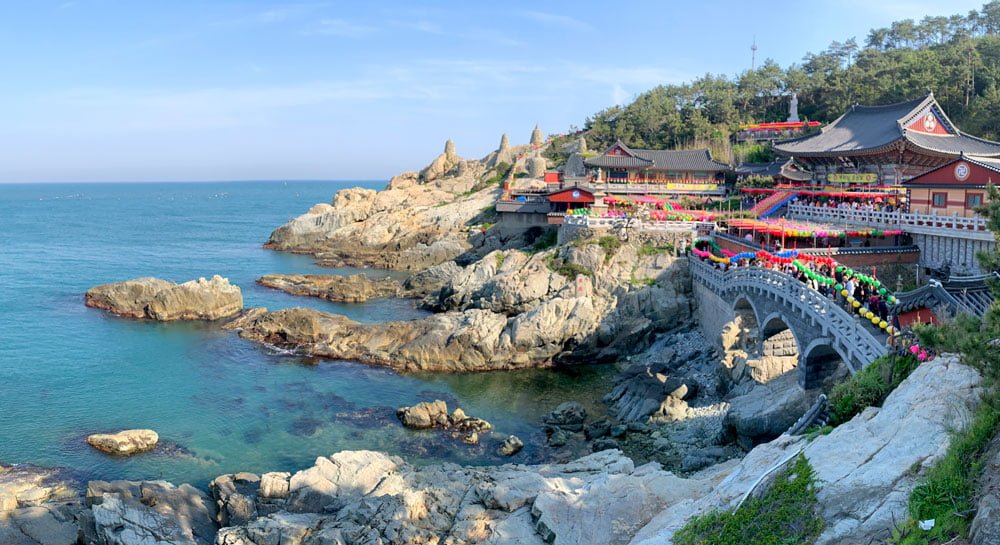
I visited Haedong Yonggungsa on a weekend which also happened to be Korea’s Children’s Day so the place was PACKED. Also, it was the weekend before Buddha’s birthday which is another big celebration for the temple, hence all the pretty and colourful lanterns on display.
The temple faces east so it’s a popular spot for viewing the sunrise, especially on New Year’s morning.
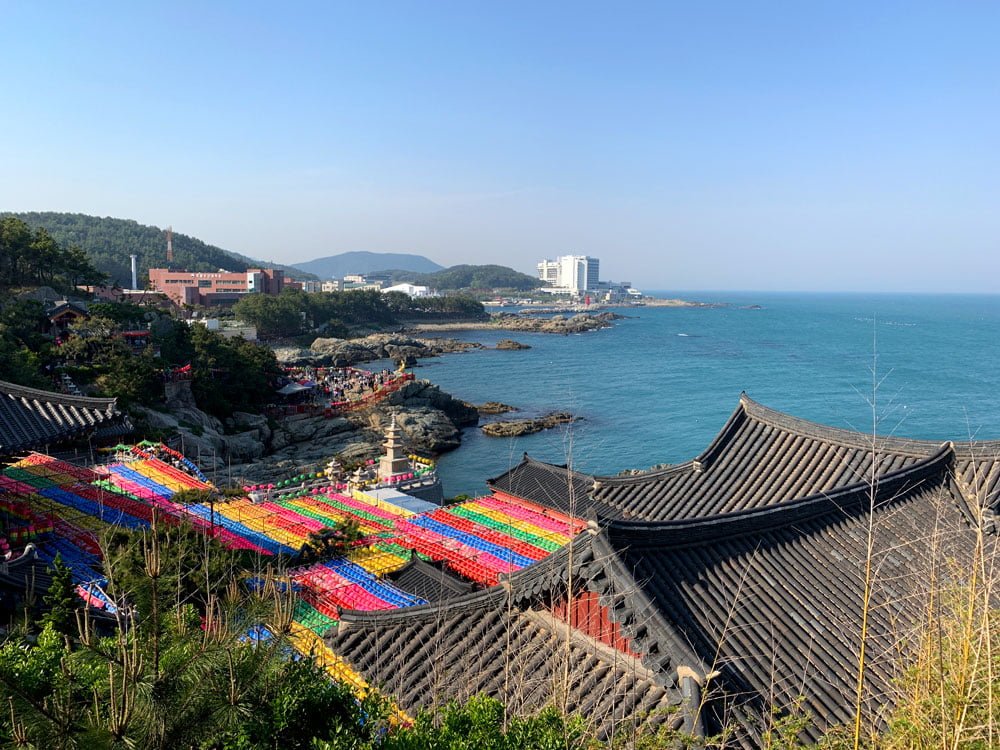


Haedong Yonggung Temple 해동 용궁사 (Haedong Yonggun-sa) [Naver Maps]
Opening Hours: Open 5am to sunset. Free entrance. I suggest going earlier in the day as it is generally less crowded in the mornings. If you are ambitious, you can try to catch the sunrise over the ocean as it does face east.
How to get there: Take the Busan Metro Green Line 2 to Haeundae Station 해운대 Exit 7, and transfer to Bus 181 to Yonggusa Temple/National Fisheries Stop [Naver maps]. From the main road, there’s a short 5-10 minute walk to get to the temple complex.
There are other buses you can take like 1001, 100 and 139. More details on transport options at the temple website.
What’s nearby: Lotte World Adventure Busan is a pretty large theme park not far away from the temple, along with a giant mall and outlet shopping.
Gwangalli Beach 광안리 해수욕장
Another famous beach in Busan is Gwangalli Beach located in Suyeong, renowned for fine white sand and a view of the impressive Gwangan Bridge that spans the cove. I visited Gwangalli Beach at night when the bridge was all lit up and was treated to some impromptu fireworks on the water and the beach.
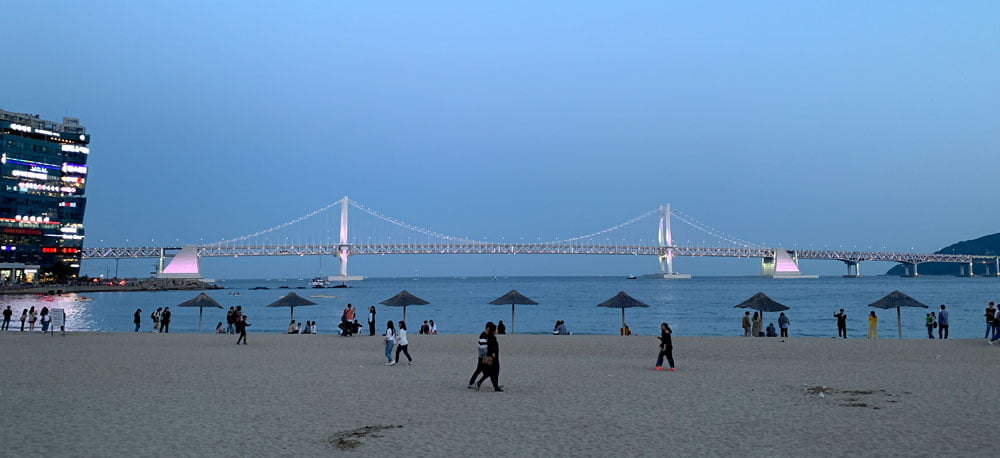
The atmosphere is really nice in the evening, with lots of buskers and night lights and there were even projections onto the sand like an art installation that night. There are plenty of eating and drinking places along the beach as well. On Saturdays, there is now a permanent drone show that happens every evening.
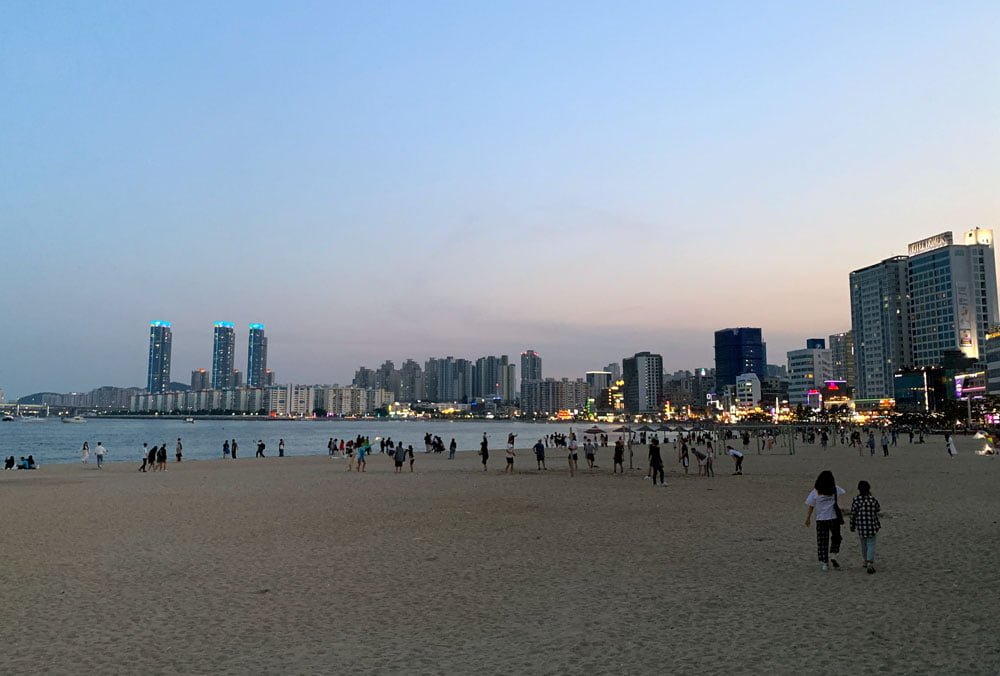

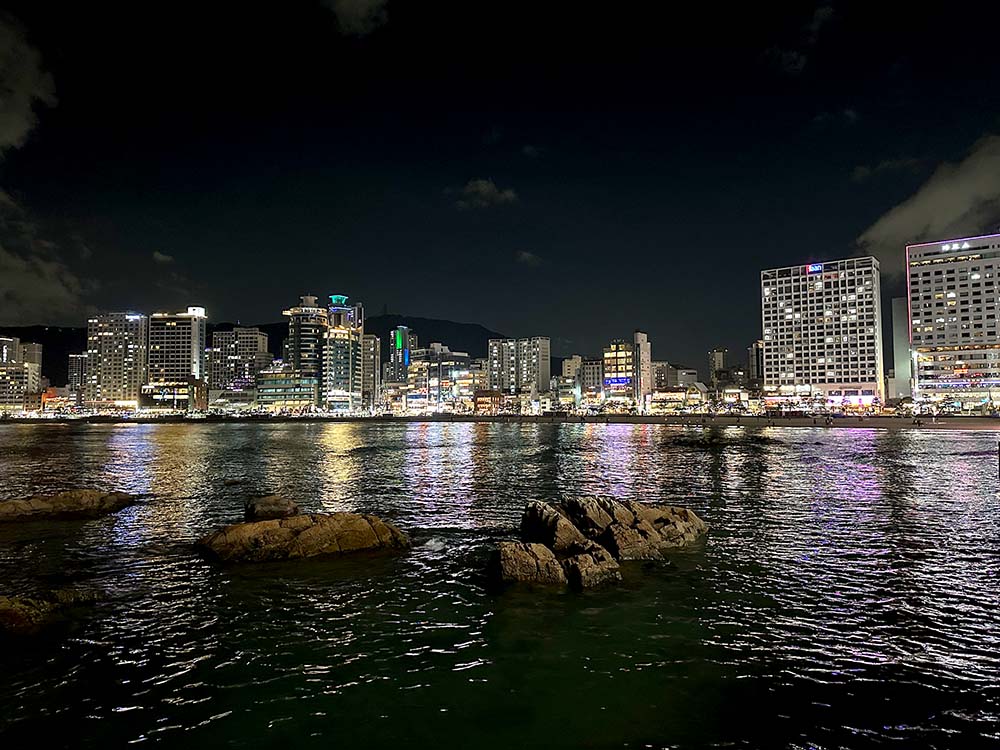
Gwangalli Beach 광안리 해수욕장 (gwang-anli haesuyogjang) [Naver Maps]
- Gwangalli Beach Drone Show – 8pm & 10pm (Mar – Sep), 7pm & 9pm (Oct – Feb)
Opening Hours: Swimming time from 9am – 6pm. More at Suyeong Website.
How to get there: I took the Busan Metro Green Line 2 to Gwangan Station 광안 and then a short walk to Gwangalli Beach. This puts you on the northern end of the beach. You could also stop at Geumnyeonsan Station 금련산역 on the same line which is closer to the southern end of the beach.
Galmegi Brewing 갈매기브루잉
For dinner, I checked out Galmegi Brewing, an American-style craft brewery just off the main Gwangalli Beach stretch. Perhaps it was a weekday, but only the 2nd level was open and you had to go up by the fire exit stairs. But the bar itself was very hipster chillax and I had some beer and Spanish-style prawns for dinner that night.
I visited the main brewery and original location, but they do have several outlets in Busan, including one on Haeundae Beach and another in Seomyeon.
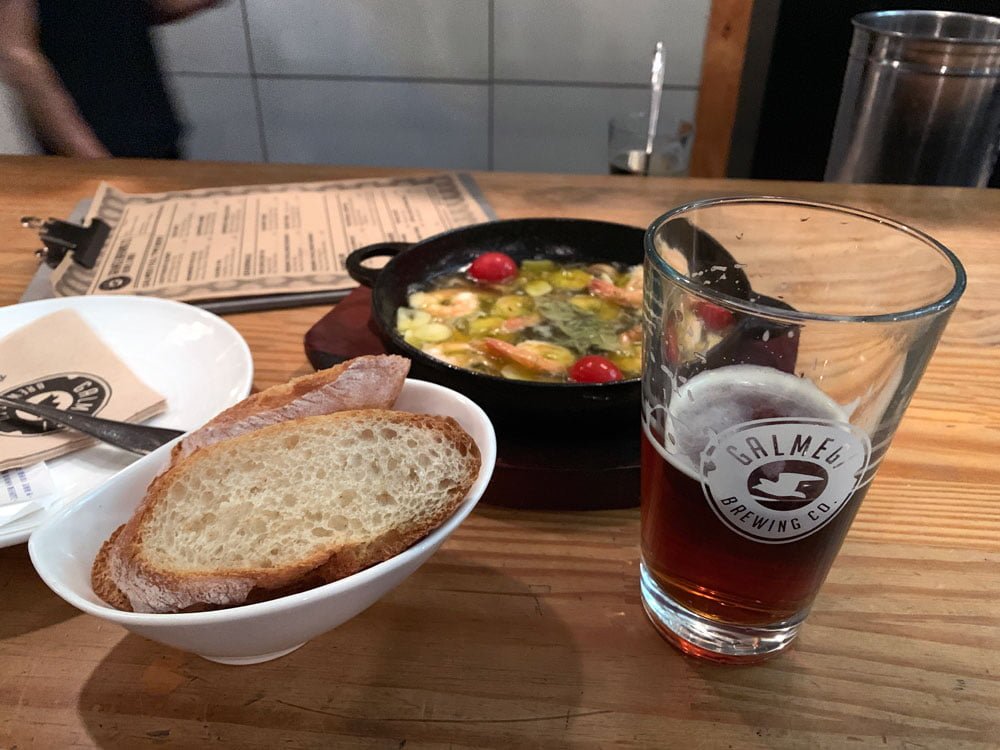
Galmegi Brewing 갈매기 브루잉 광안 본점 (galmaegi beulu-ing gwang-an bonjeom) [Naver Maps]
Opening Hours: Open 4pm-1am, closed on Sundays.
How to get there: Located off the south end of Gwangalli Beach at 58 Gwangnam-ro. A short walk from Geumnyeonsan Station Exit 5 (Green Line 2).
Millac The Market 밀락더마켓
On the eastern end of Gwangalli Beach is the Millak district which is famous for its live fish markets which you can also enjoy the Gwangan Bridge view from. Here is a newish designer and cultural space called Millac the Market built like an old warehouse but made of glass.
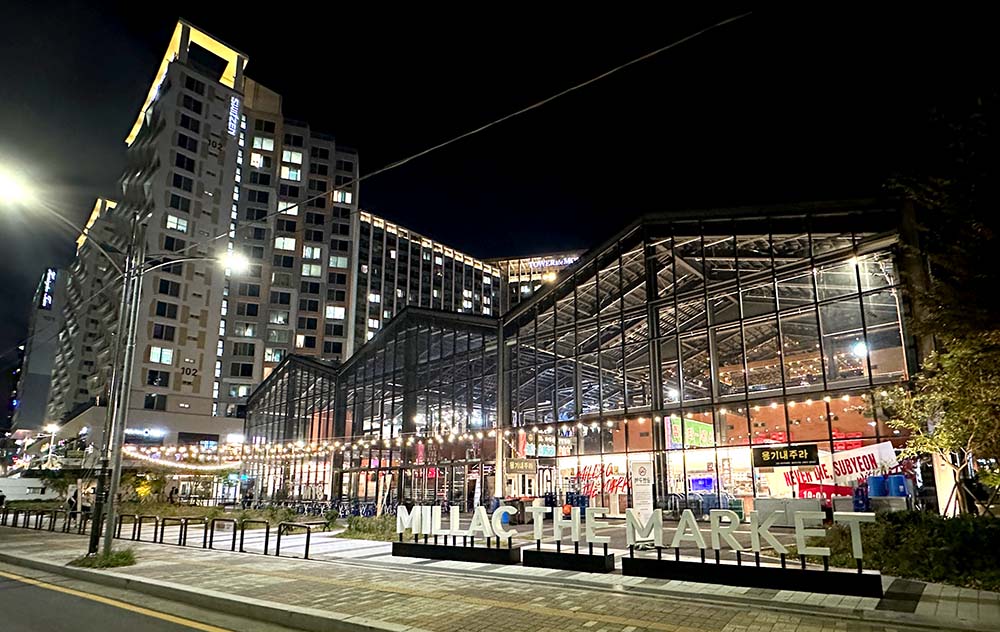
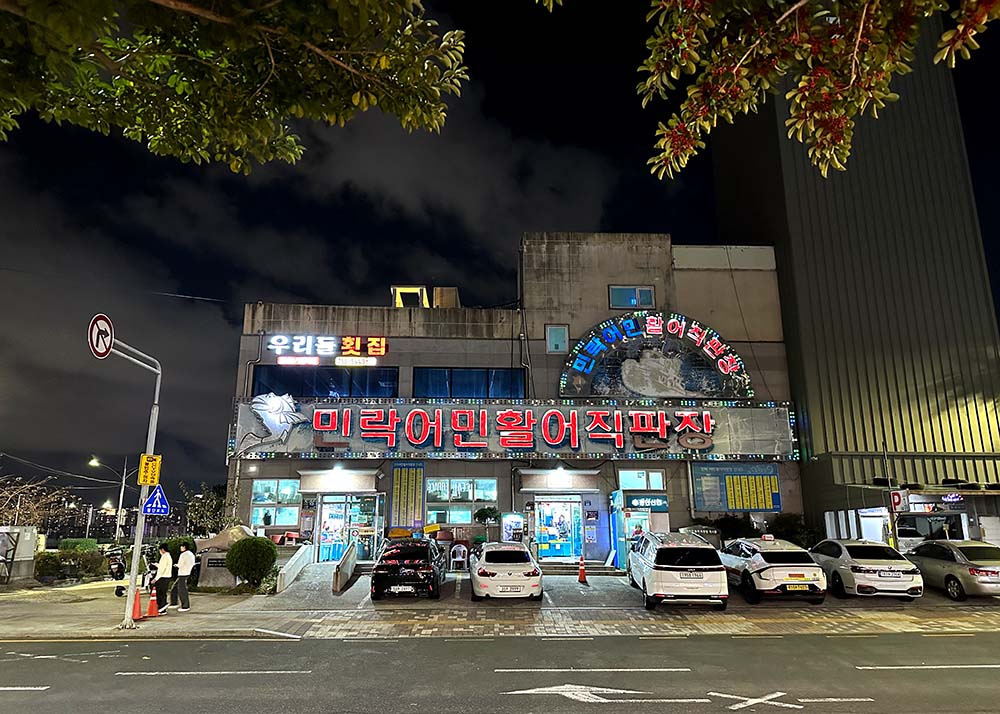
The market is set up a bit like a department store with little stalls selling clothes, knick-kacks and food. It also has a great chillout spot facing the bridge with lovely views of Gwangan bridge.
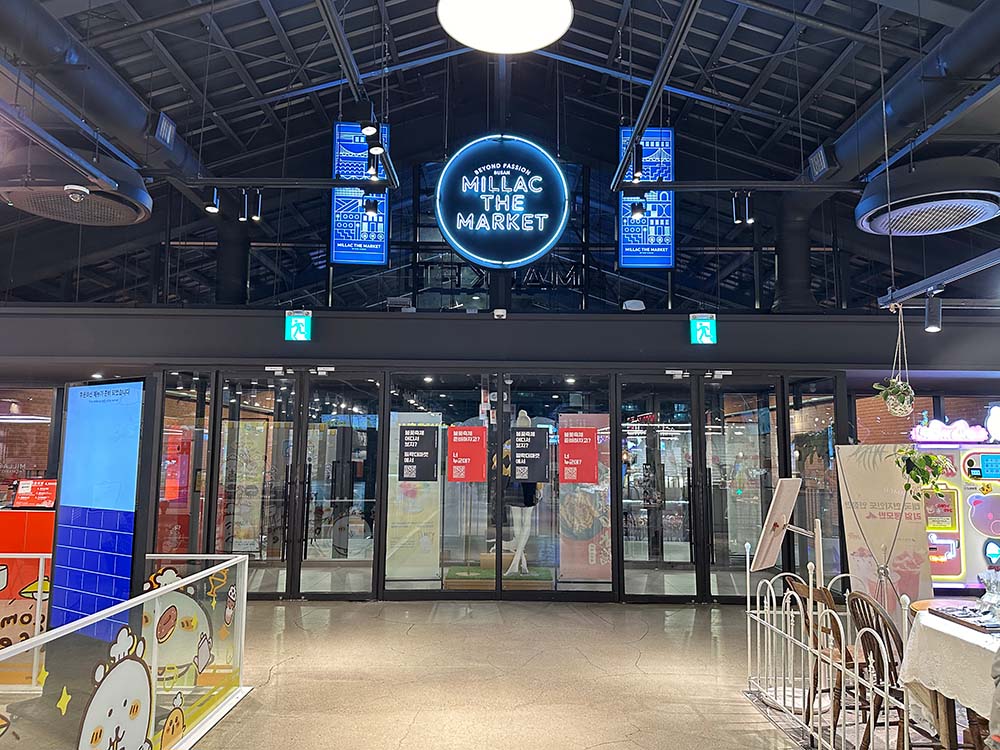
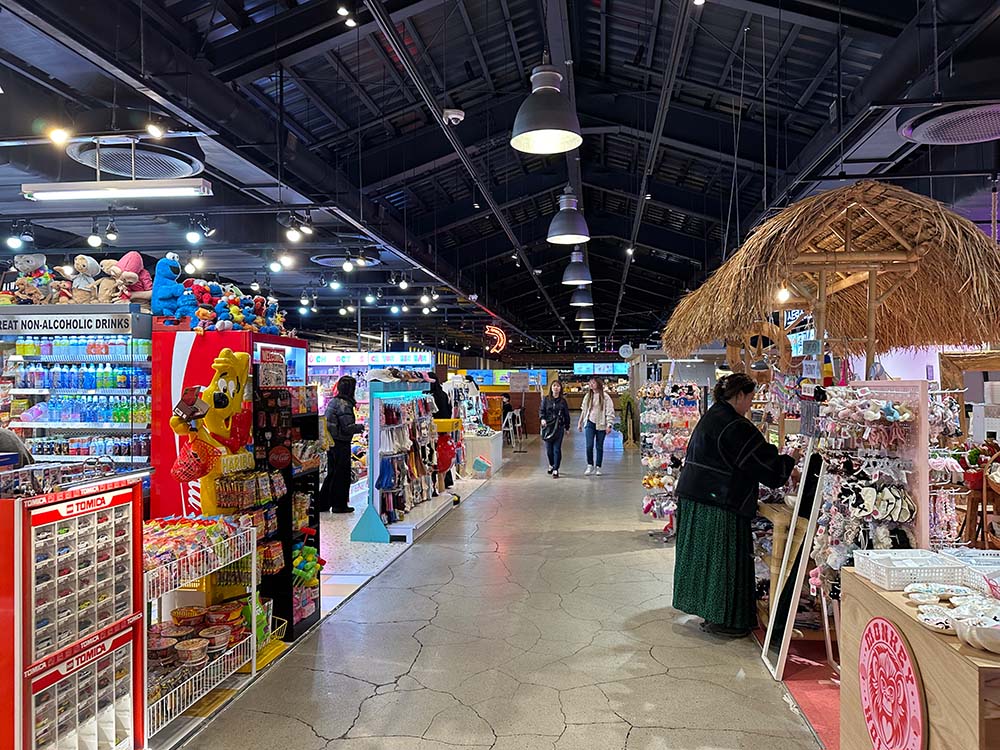
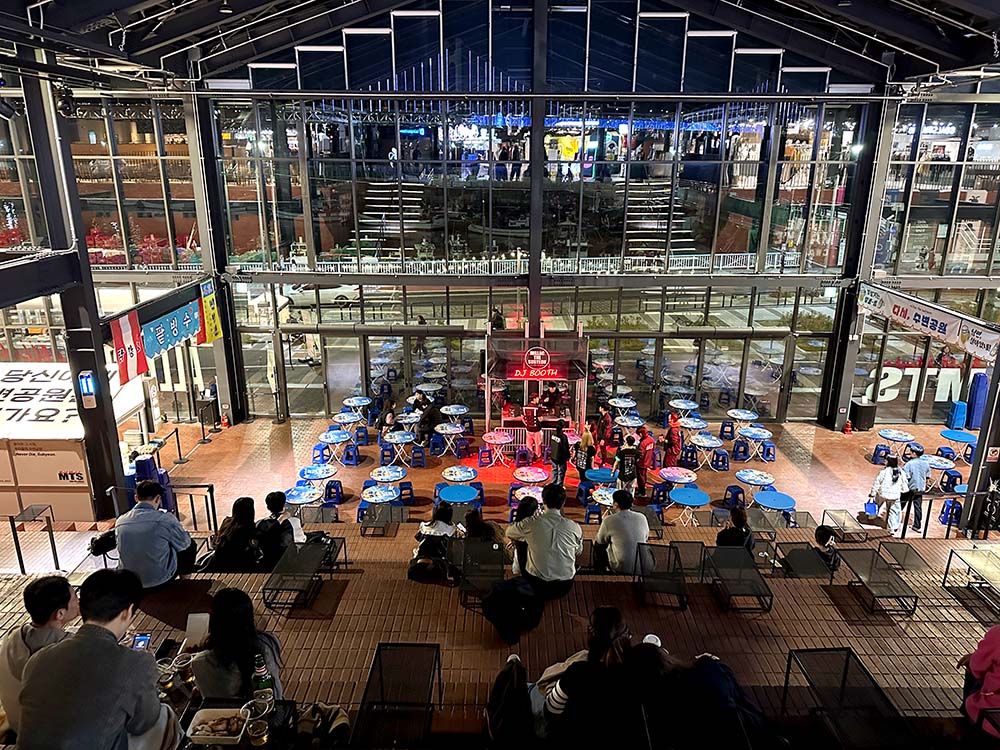
Millac The Market 밀락더마켓 [Naver Maps]
Opening hours: 10am – midnight
How to get there: Millac the Market is about 10 minutes walk east of Gwangalli Beach which is a short walk from Gwangan Station on Metro Green Line 2.
Where to stay in Haeundae
You could choose to stay in Nampodong which is about 20-30 minutes away by taxi if traffic isn’t too crazy, but staying in Haeundae would be more convenient for seeing east Busan or if you plan to enjoy the nightlife in this area.
L7 Haeundae by LOTTE
L7 is a more modern and hipster hotel chain under the LOTTE umbrella. L7 Haeundae is a pretty new hotel with an excellent location right on Haeundae Beach right across the road. Haeundae Market was also right by the hotel.
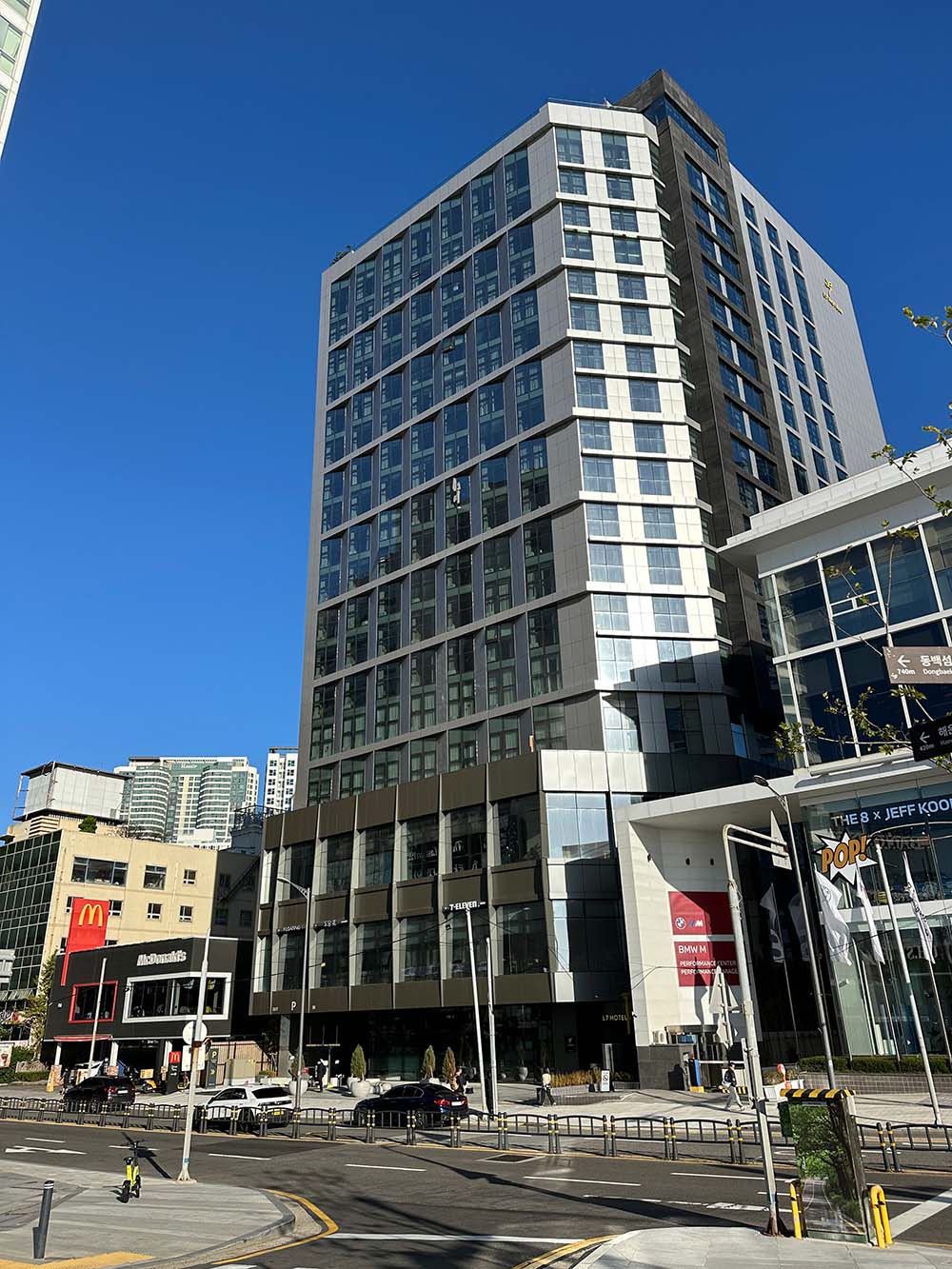
I had a room with a partial view of Haeundae Beach from my bed, so I could enjoy the sunrise if I woke up early enough, as well as bask in the sunset glow from my window.
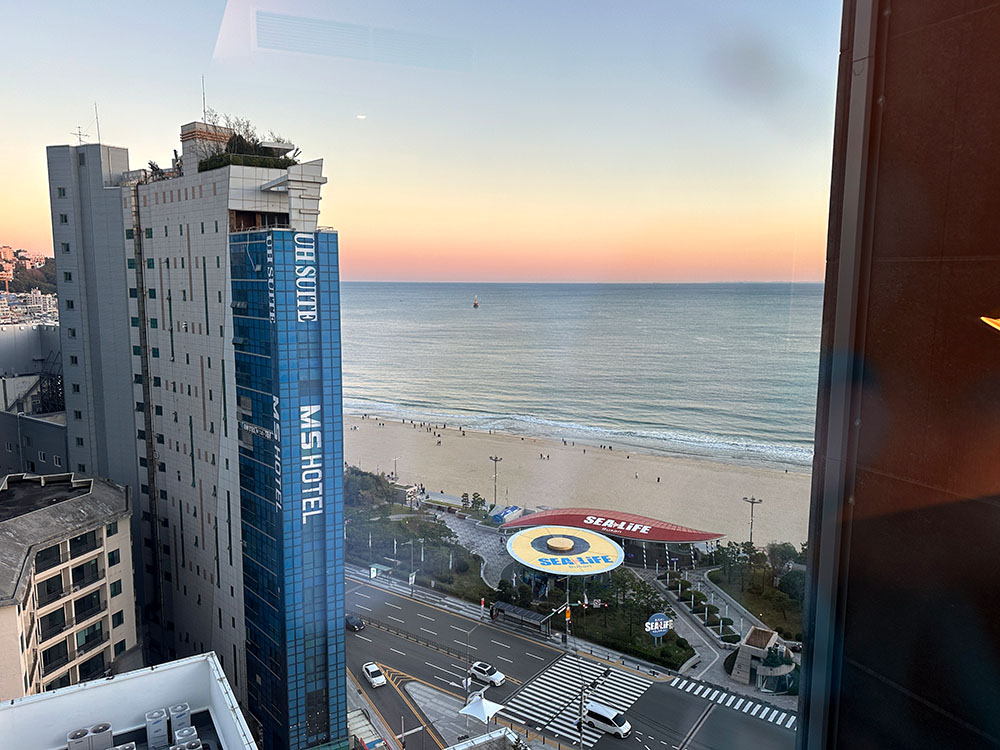
The room was snug but quite comfortable overall, I like the more modern sensibilities of the hotel design. Lots of wood and no carpets, though I found the open cupboard area a tad small – I couldn’t fit my luggage in there. The toilet and shower were in separate cubicles right by the doorway with the sink
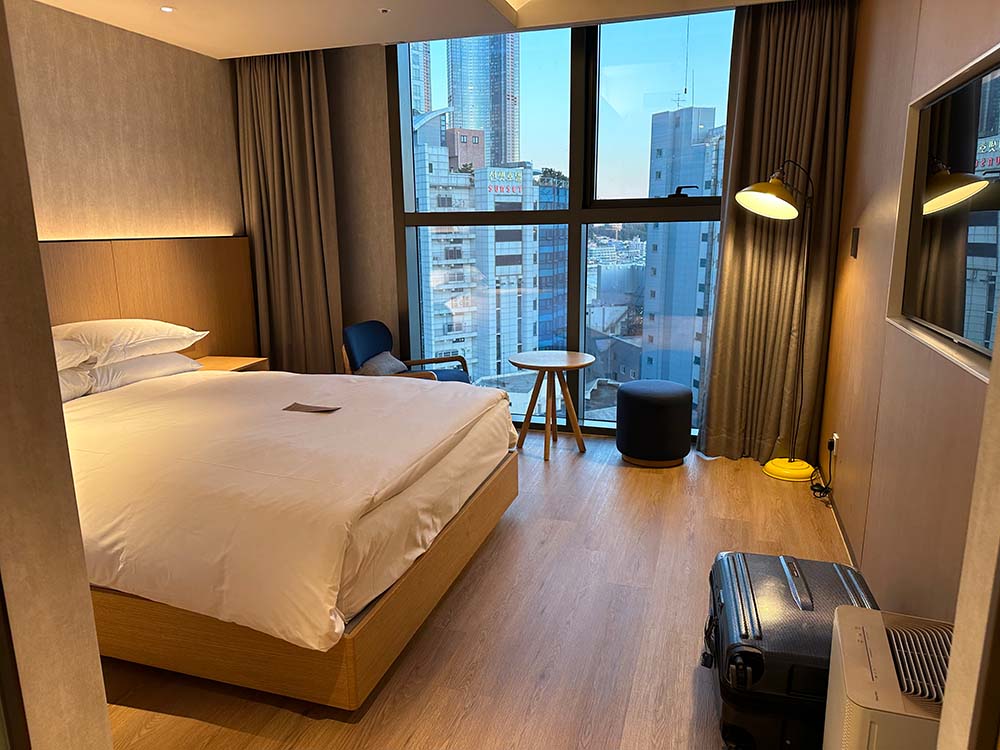
L7 Haeundae by LOTTE / L7 해운대 바이 롯데 [Naver Maps]
- L7 Haeundae website
- L7 Haeundae on booking.com [affiliate link]
- L7 Haeundae on Klook [affiliate link]
Rates: Room rates start from 90,000 KRW per night
How to get there: L7 is right across the road from Busan Sea Life Aquarium along Haeundae Beach, which is closest to Metro Green Line 2.
More places to stay in Haeundae
Here are some other places I would stay at in Haeundae if I have the chance to return in the near future. [booking.com affiliate links]
- Noel Business Hotel
- MAMA Guesthouse Haeundae
- The Solid Residence – Elbon the Stay by Haeundae
- H Avenue Gwangan-ri Beach
Looking for more things to do in Busan? Check out other places to see in Korea’s southern region.

